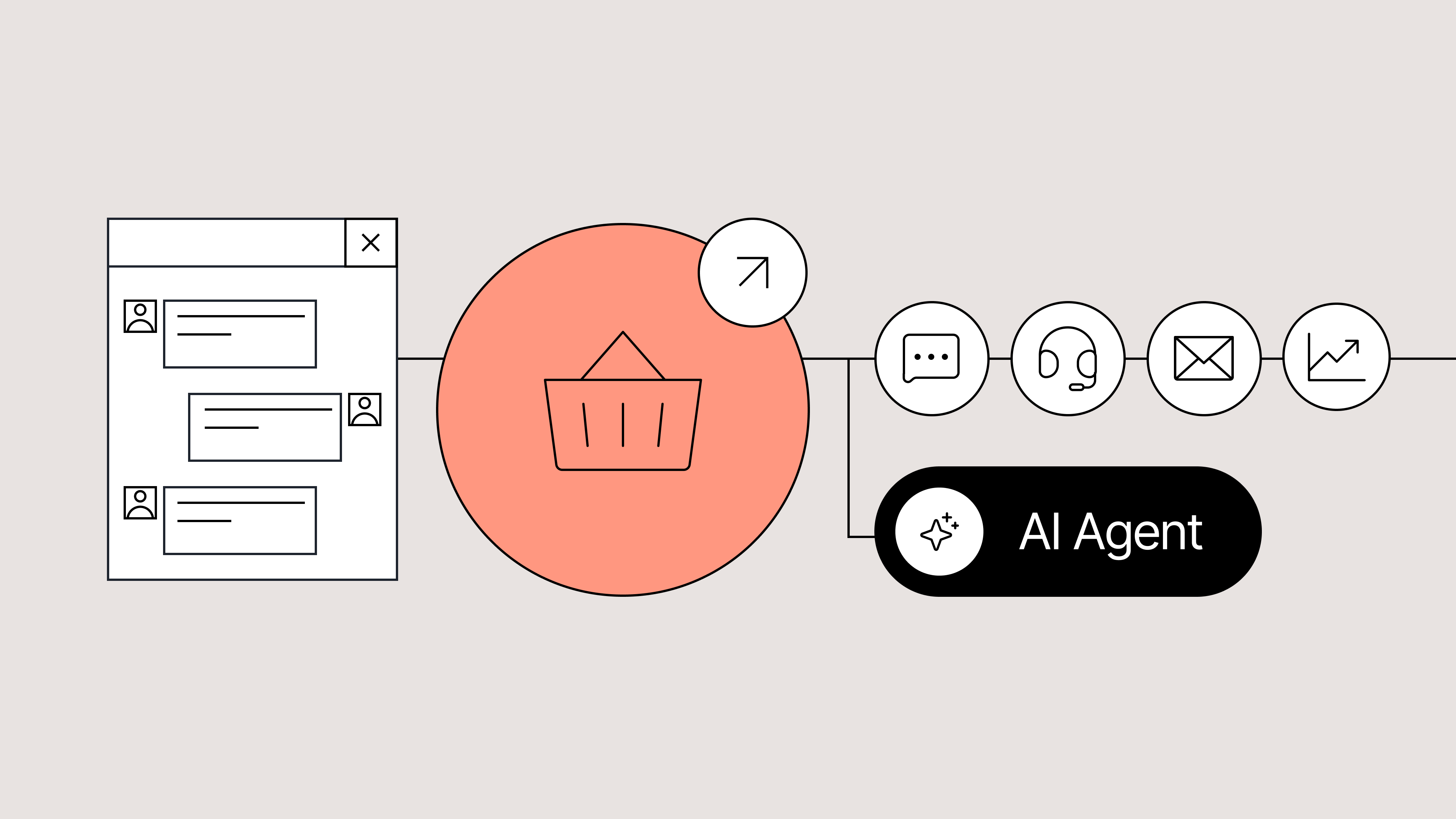


How Online Sizing Solutions Are Replacing the Fitting Room
TL;DR:
- 58% of fashion shoppers “bracket” orders—buying multiple sizes and returning what doesn’t fit. This drives high return rates, increased costs, and customer frustration.
- 70% of returns are due to sizing issues. Nearly half of shoppers abandon carts over inconvenient returns.
- Leading solutions include: AI-powered fit tools, 3D visualizations that show scale and model stats, “fit finder” tools, at-home fitting experiences, and AI-powered customer support.
- Brands that replicate the fitting room online gain higher retention, lower costs, and stronger sustainability.
Sizing has long been a friction point for ecommerce fashion shoppers.
Without the ability to try items on, 58% of shoppers resort to "bracketing"—ordering multiple sizes of the same piece and returning what doesn’t fit.
While it gives customers a temporary fix, it ultimately creates frustration for them and logistical headaches for brands.
The result is rising return rates, higher costs, and wasted resources. To break this cycle, ecommerce brands need to rethink how they guide shoppers toward the perfect fit. The good news is that many brands are already showing the way by using AI-powered tools and smarter product experiences to replicate the fitting room from the comfort of home.
{{lead-magnet-1}}
Returns are getting unsustainable
Recent data highlights just how severe the return challenge has become for fashion and apparel retailers:
- 46% of shoppers have abandoned a purchase because return methods were inconvenient.
- Fashion and apparel brands get twice as many return requests than any other industry.
- According to Gorgias data, 70% of returns are due to sizing confusion.
- “Will this fit me?” is one of the top reasons customers contact support.
In addition, rapidly rising concerns around sustainability and climate change, as well as heightened awareness around over-consumption, are prompting consumers to make changes in their purchasing habits.
Brands who prioritize well-fitting, long-lasting pieces and reduce carbon footprints and the amount of clothing diverted to landfills by lowering returns can actually benefit from a strategic edge.
“Those who choose to approach sustainability with a long-term mindset even while battling short-term problems will be rewarded with more efficient business operations and a competitive advantage,” writes McKinsey in its State of Fashion 2025 report.
Effective sizing solutions for ecommerce brands
Most brands already have size charts, but shoppers don’t want to measure themselves, or find those charts to be inaccurate.
When shoppers lack confidence in choosing the right fit, they either abandon their carts or rely on bracketing, both of which lower profitability and customer trust.
Forward-looking fashion and apparel brands are solving sizing issues by using tools for a more intuitive shopping experience. This ultimately helps them build loyalty, increase retention, and reduce returns.
Implement AI-powered body measurement tools
Rather than purely providing static size charts on your website, opt for AI-generated personalized fit recommendations instead.
For example, European fashion retailer Zalando reduced size-related returns by 10% using AI-driven advice.
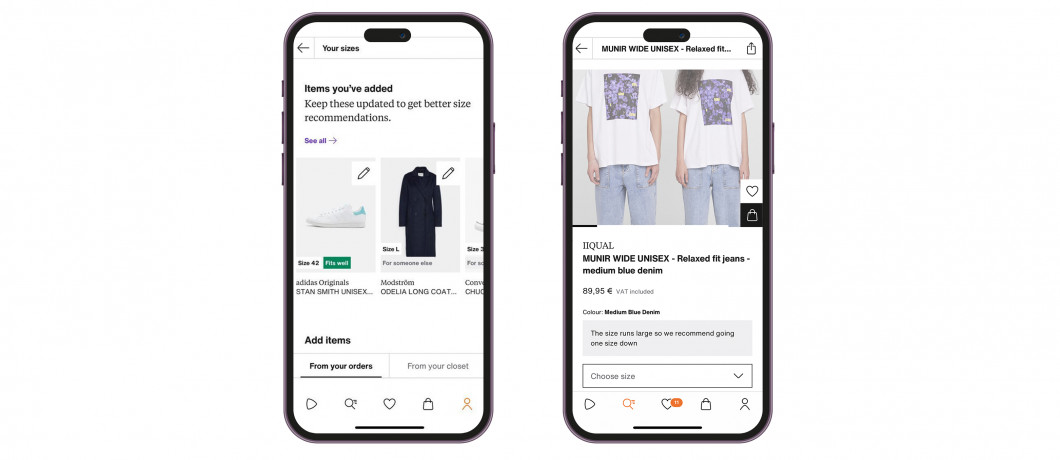
The brand flags whether an item is true to size or not. It also offers the ability for customers to see recommendations based on logged fit-based return reasons, past purchases, and other clothing items that fit them well.
Zalando also launched a body measurement feature in 2023 where shoppers can actually scan themselves for more accurate size advice.
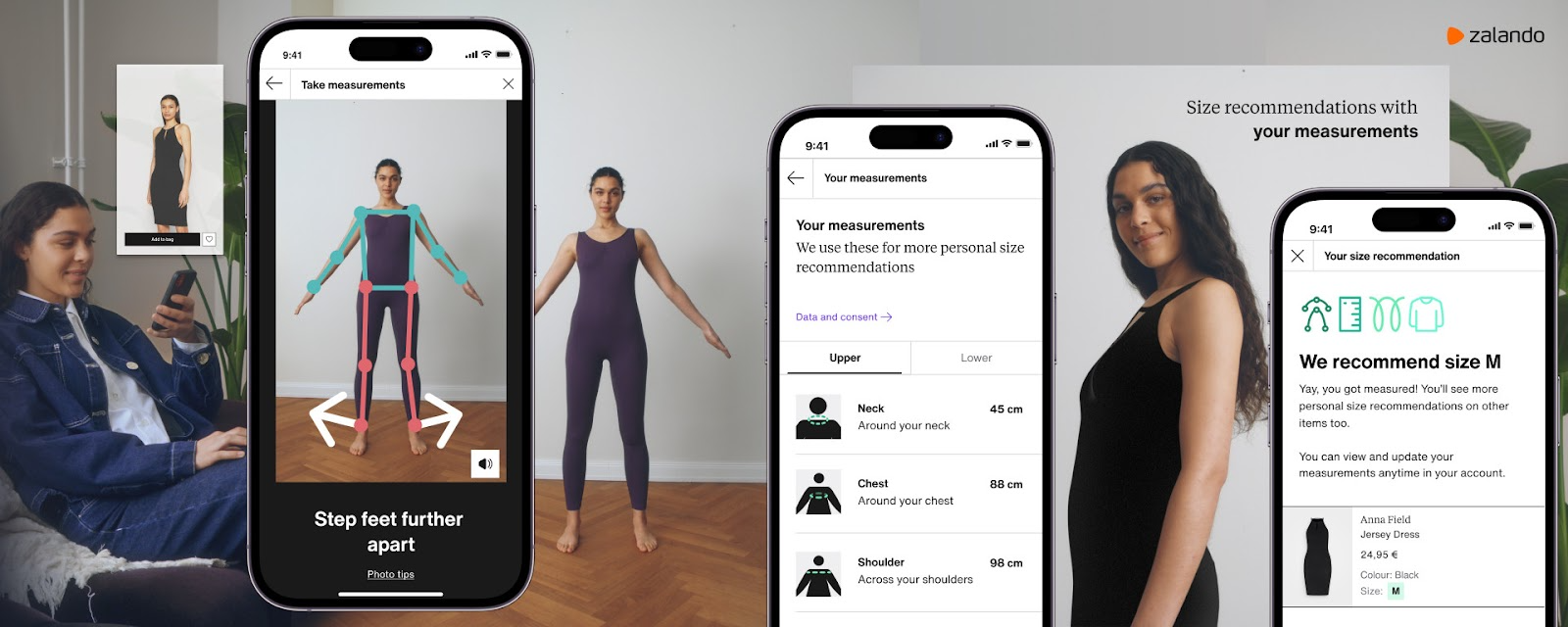
Show size and scale in product photos
As AI grows in proficiency, there are more tools than ever to help shoppers visualize product scale and fit.
For example, accessory shop LeSportsac uses Tangiblee, a product experience tool, to help customers understand scale and what fits inside each bag.
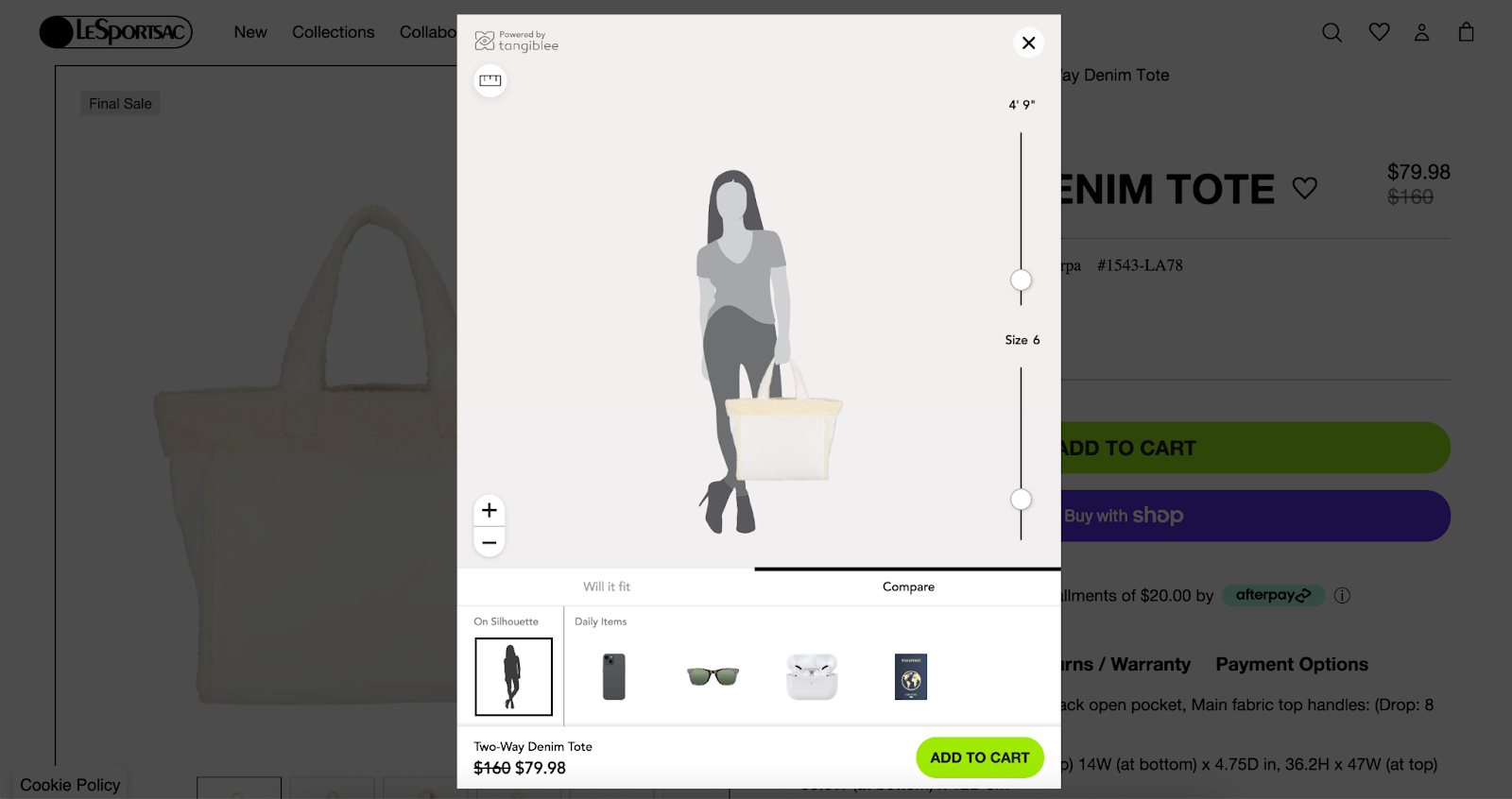
Performance hunting gear shop KUIU takes another approach. It uses a photo-based layering guide, so shoppers can see how the size and fit look with multiple layers on a model. Different model stats shown within product photography give contextual sizing cues.
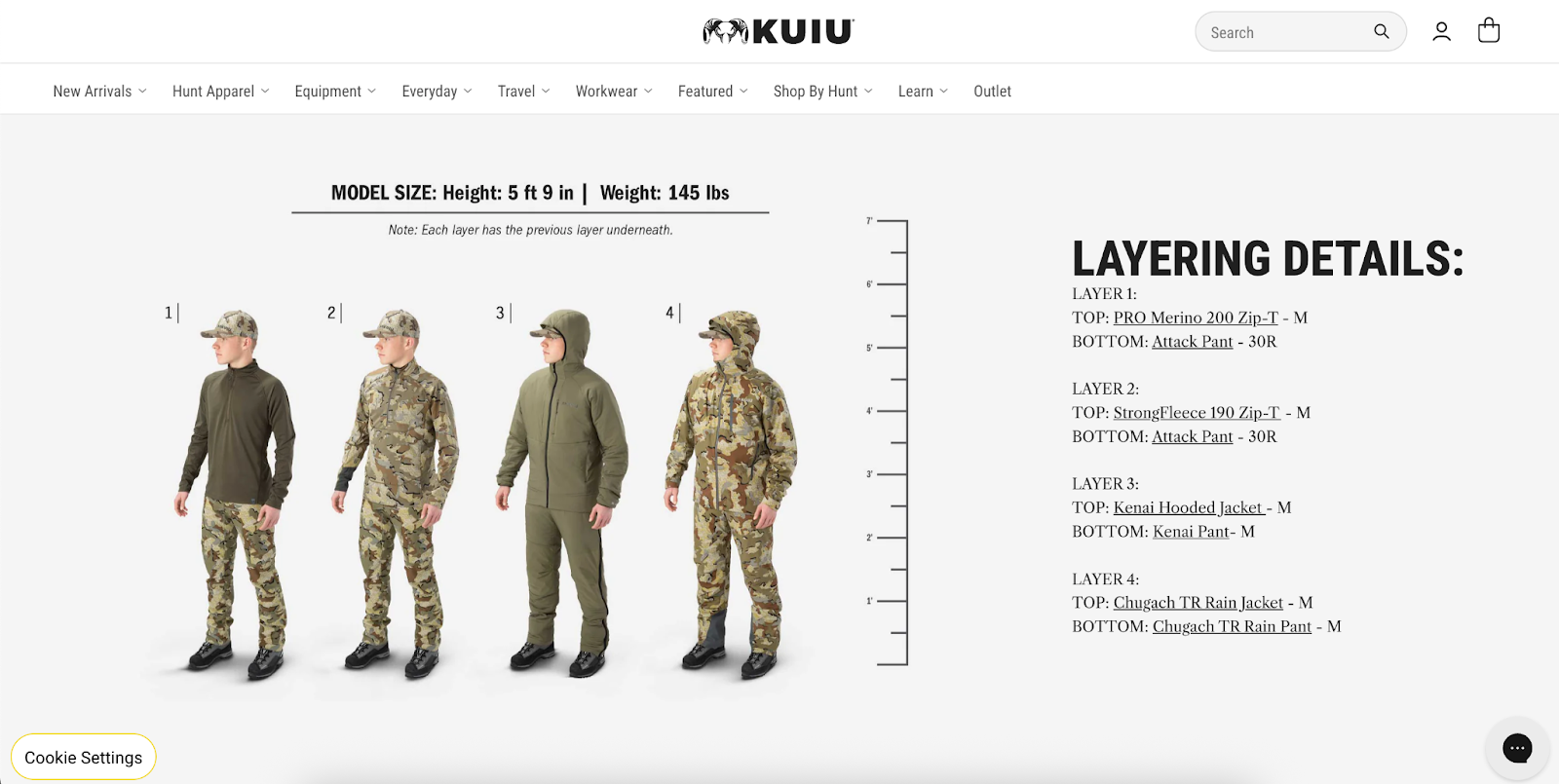
Sleep shop Cozy Earth takes a similar route, stating model height and size on product photos.
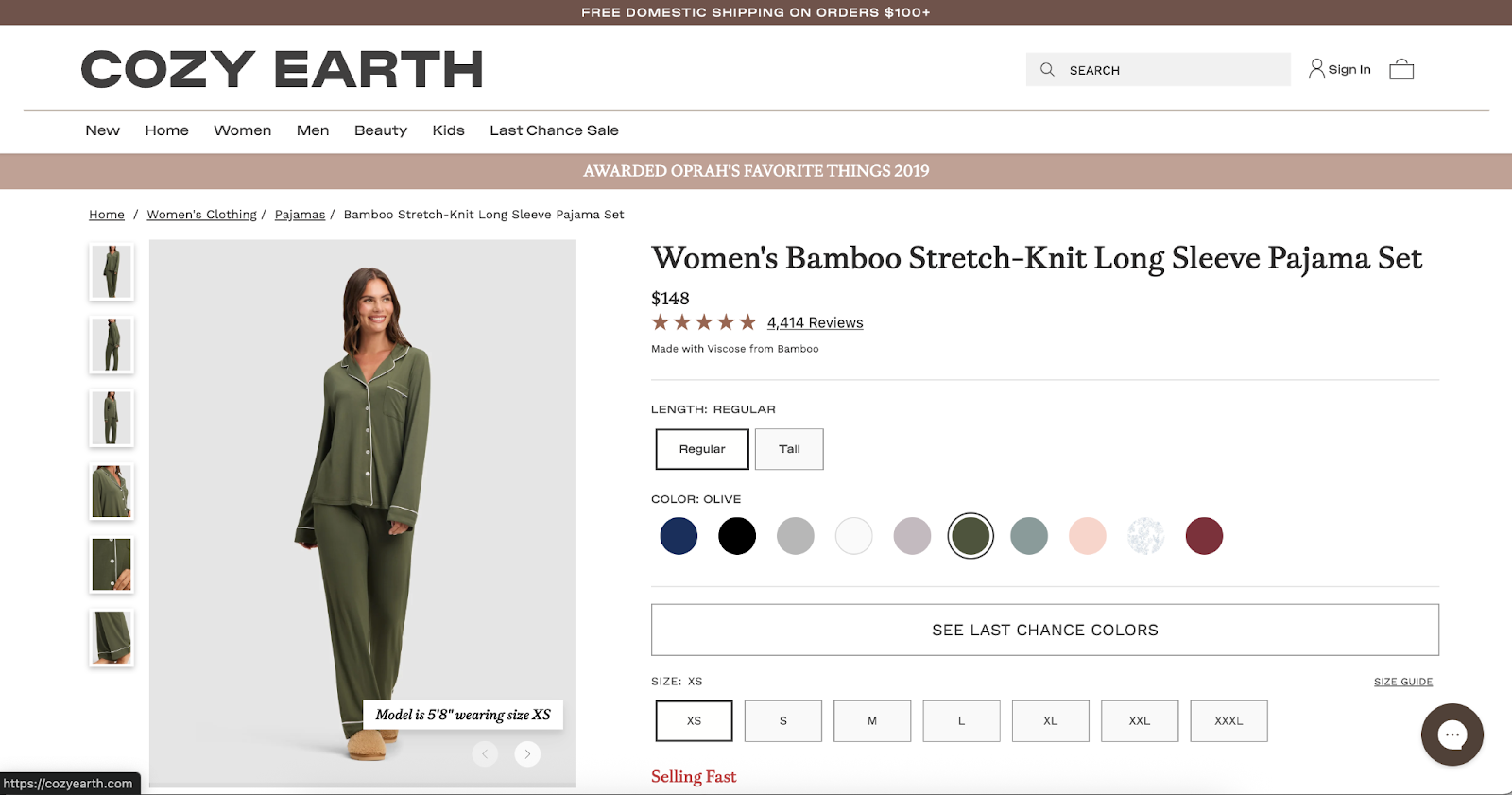
Introduce “fit finder” tools
Some brands are helping shoppers pick the right size with interactive quizzes based on factors like height, weight, and the sizes of other clothing items that fit well. SuitShop is among those brands using a Fit Finder quiz on its website.

Similarly, Psycho Bunny leverages the AI tool True Fit as a size finder on product pages.
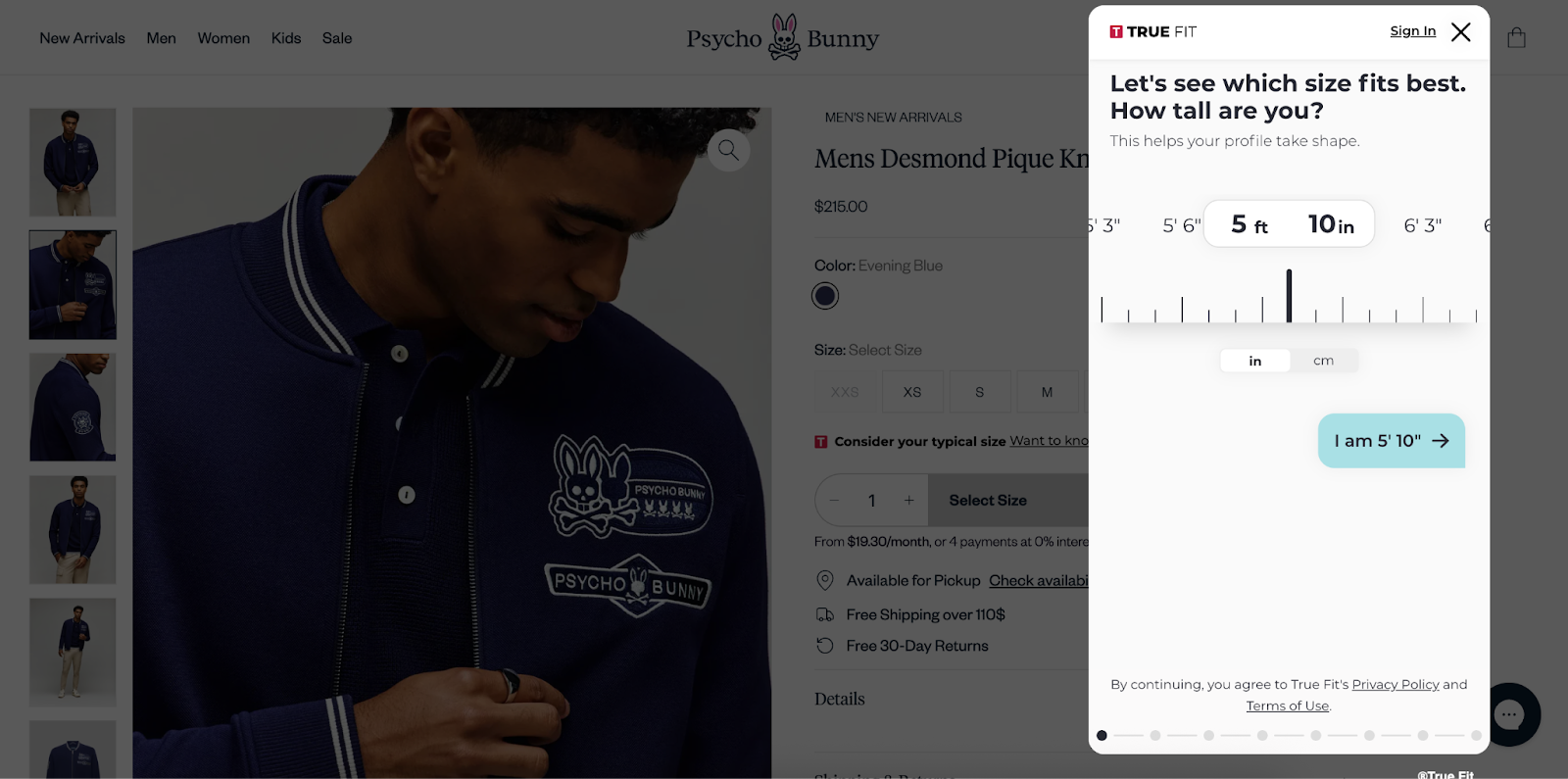
Bring the fitting room home
Ergonomic shoe brand Orthofeet eliminates sizing qualms altogether by including customizable inserts inside each box. Fitting spacers ensure a snug fit and arch enhancement for those who need it, helping shoppers get comfortable shoes that fit.

Jonas Paul Eyewear shares the “try it on at home” approach, offering a free or low-cost home try-on kit.

Leverage AI-powered customer support
Gorgias Shopping Assistant helps brands meet that need by delivering human-like guidance at scale, giving shoppers instant answers that feel personal.
For example, VESSEL uses Shopping Assistant in chat to provide real-time support on sizing and inventory, helping customers choose with confidence. By addressing fit questions directly, Shopping Assistant reduces returns and builds trust at the point of purchase.

Similarly, outdoor clothing retailer Arc‘teryx provides an “ask me anything” AI chat where shoppers can confirm any questions they have around fit or sizing.
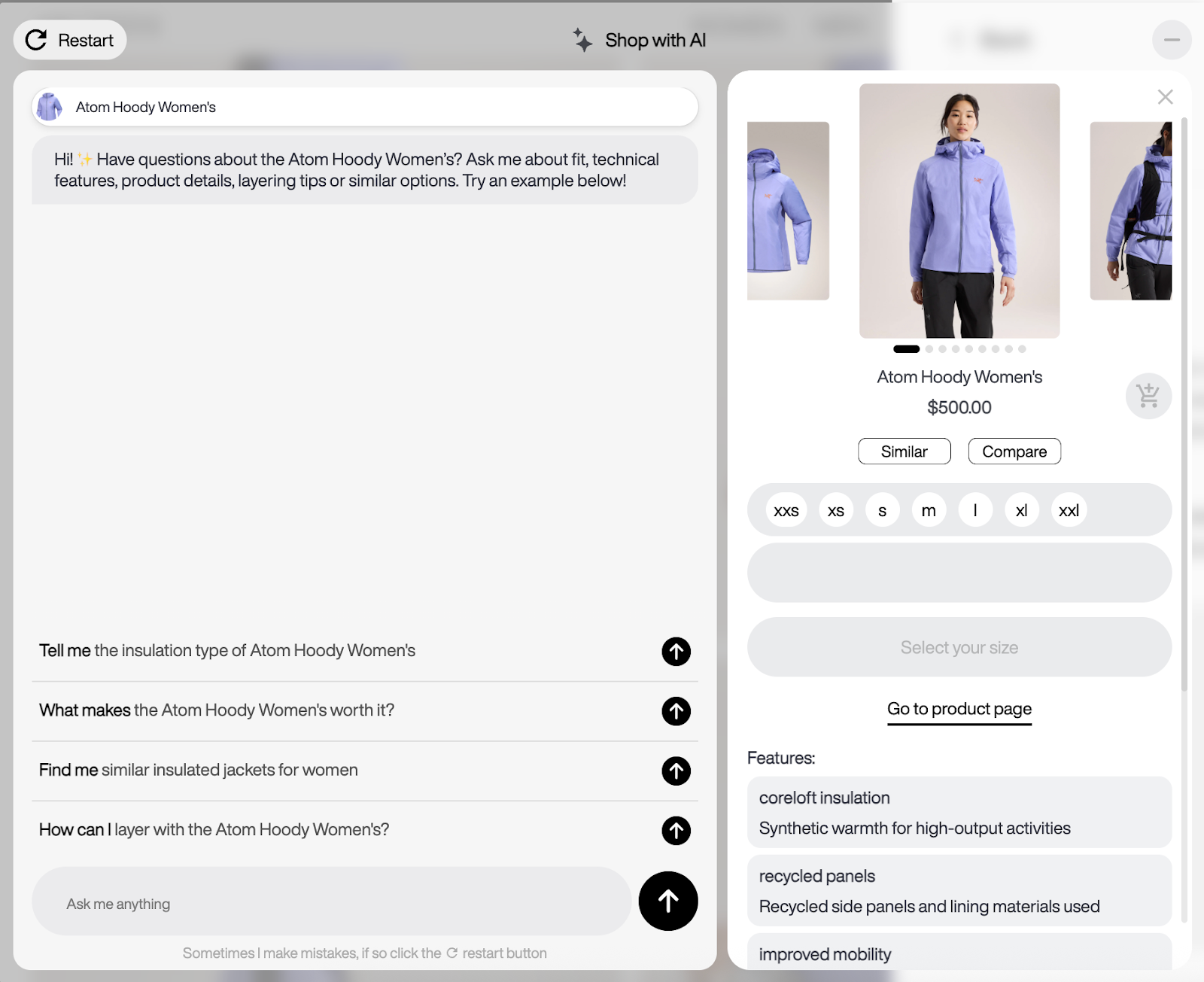
The future for ecommerce size guides
Sizing for ecommerce fashion and apparel brands has become a business-critical challenge. With 70% of returns tied to fit issues and nearly half of shoppers abandoning purchases over inconvenient returns, brands that replicate the fitting room online stand to gain a competitive advantage.
From Zalando’s 10% reduction in size-related returns to VESSEL’s use of AI-powered chat, the path is clear: investing in smarter size chart solutions pays off with higher retention, lower costs, and stronger sustainability.
The brands that provide fitting room-level experiences online now will set themselves apart from the rest.
Book a demo to see how Gorgias, the leading conversational commerce platform, helps fashion brands cut returns, drive sales, and deliver fitting-room level experiences online.
{{lead-magnet-2}}
TL;DR:
- Conversational commerce replaces static support with real-time conversations. Instead of making customers wait or dig through FAQs, brands can respond instantly via chat, messaging apps, and voice assistants.
- The main types are live chat, AI assistants, messaging apps, and voice support. Each helps guide shoppers and answer questions instantly.
- It’s most effective during key moments like cart hesitation, post-purchase anxiety, and peak seasons. Proactive conversations reduce drop-offs and boost conversions.
- Start small and scale. Begin with repetitive questions or cart recovery, then layer in automation and AI as you grow.
While your competitors are still making customers wait days for email replies, the smartest brands are having conversations that close sales in real time.
Instead of forcing customers to search through FAQs or go through an automation loop, conversational commerce lets you have instant chats through live chat, messaging apps, and even AI assistants.
In this guide, we’ll explain conversational commerce, where it delivers the most value, and how to start using it to drive revenue and improve CX without overwhelming your team.
What is conversational commerce?
Conversational commerce means using real-time, two-way conversations as your storefront. Rather than bottling up questions in FAQ pages or forcing customers to wait for your support team to respond, you can instantly connect via:
- Chat
- AI agents
- Messaging apps
- Voice assistants
Maybe someone is on your product page and asks a question like, “Does this jacket run large?”. Through chat, they get an instant answer, increasing the chance of a sale. Or a shopper receives personalized recommendations via WhatsApp and checks out, all without leaving the app.
These channels allow you to meet customers where they already are, effortlessly. When paired with AI chatbots, you can deliver fast, accurate responses 24/7, even while your team is off the clock. That means better experiences for your customers and more sales captured for your brand.
Conversational commerce bridges the gap between shopping and support. It turns your support team (and AI tools) into revenue drivers by helping shoppers feel seen, heard, and ready to buy.
Types of conversational commerce
Conversational commerce means bringing your storefront into the flow of conversation, wherever that happens for your customers.
Here’s where those conversations typically happen:
- Live chat
- AI assistants
- Messaging apps
- Voice assistants
1. Live chat
This is a chat widget on your site, often in the bottom right corner, where shoppers can ask questions and receive immediate answers from a human agent or automation.
It’s a quick path to support or purchase, which one agent can manage multiple chats from simultaneously, boosting efficiency and keeping things personal.
2. AI assistants
These smart helpers use Natural Language Processing (NLP) to understand what shoppers mean beyond what they type. They guide customers through questions, offer product suggestions, handle FAQs, and can sometimes complete transactions right in the chat, even handling post‑purchase support like order status or returns.
Natural Language Processing (NLP): The processing of understanding and interpreting natural language using computers. NLP is used in tasks such as sentiment analysis, summarization, speech recognition, and more.
3. Messaging apps
Think WhatsApp, Facebook Messenger, WeChat, and SMS—the apps where customers already spend their time in their day-to-day. Instead of sending them to shop on your website, you bring the shopping to them. Answer their questions, provide recommendations, and win purchases in a channel they already trust.
4. Voice assistants
Voice assistance isn’t limited to smart speakers like Siri and Alexa anymore.
Now, AI voice support lets brands deliver natural conversations over the phone, without needing a massive contact center team. These AI voice agents can:
- Answer common questions using branded knowledge
- Route calls or escalate when needed
- Handle returns, exchanges, or order tracking
- Personalize support based on customer intent and past behavior
AI-powered voice support combines the human feel of a phone call with the speed and accuracy of automation. It's especially useful for high-ticket products, customers who prefer calling, or peak season overflow when your human team is maxed out.
The benefits of conversational commerce for ecommerce brands
Conversational commerce isn’t a CX buzzword. When done right, it directly impacts your bottom line.
Here’s how it pays off for ecommerce brands:
- Higher conversion rates
- Faster and more efficient support
- Bigger carts, fewer drop-offs
- Stronger customer relationships
1. Higher conversion rates
When customers can ask questions and get answers in real time, whether it's sizing info, shipping details, or help choosing between products, they’re far more likely to hit “buy.”
Success story: Clothing brand Tommy John generated $106K+ in sales in just two months through conversation-led upselling and cross-selling, with a 15% conversion rate.
2. Faster and more efficient support
Conversational commerce tools like AI agents help offload the repetitive support tasks, including answering questions like “Where’s my order?” or “What’s your return policy?”
With that time back, agents get time back to:
- Handle complex or sensitive customer issues
- Follow up with VIP customers
- Collaborate with marketing and sales teams to improve processes
- QA conversations to enhance human and AI agent performance
- Update knowledge docs used by AI tools for more accurate resolutions
Instead of getting buried in basic tickets, your team gets to do the work that really moves the needle for your customers and your business.
Related: Every successful marketing campaign starts with a customer question
3. Bigger carts, fewer drop-offs
The right nudge at the right moment, like a personalized recommendation from an AI shopping assistant, can turn a single item into a full cart. You can also recover more abandoned checkouts by re-engaging customers directly through chat or a messaging app.
Read more: You’re missing out on sales without an AI shopping assistant—here’s why
4. Stronger customer relationships
Conversational commerce lets you meet customers with a human (or human-like) touch. When your brand is helpful, fast, and easy to talk to, shoppers remember and return.
In the long run, that means better customer retention, higher lifetime value, and more organic growth through word of mouth.
When conversational commerce creates the biggest impact
Conversational commerce shines brightest when the stakes are high or when the moment is just right.
Here are the critical moments where a real-time conversation can make all the difference:
- When shoppers have items in their cart but are hesitating to check out
- Right after customers place an order, and anxiety starts to kick in
- During peak shopping seasons like Black Friday and Cyber Monday
- When customers are browsing complex products like skincare, makeup, or apparel
1. When shoppers have items in their cart but are hesitating to check out
A customer’s on your product page, they’ve added an item to their cart, but are hesitating. Maybe they’re unsure about sizing, shipping time, or which variation to choose. This is where a quick, helpful chat, automated or human, comes in and becomes the difference between bounce and conversion.
Pro tip: Use proactive chat prompts based on page behavior to start the conversation before the shopper leaves.
2. Right after customers place an order, and anxiety starts to kick in
After a customer hits “place order,” expect more questions to roll into your inbox. Where’s my order? How do I track it? What’s your return policy? Post-purchase excitement—and anxiety—is normal, and a smart AI agent helps you get ahead of these questions while putting customers at ease.
3. During peak shopping seasons like Black Friday and Cyber Monday
Black Friday. Holiday rush. Product drops. These are prime opportunities to boost revenue—but they also flood your support team. Conversational commerce tools help you scale without sacrificing quality, keeping shoppers happy and sales flowing.
4. When shoppers are browsing complex products like skincare, makeup, or apparel
If you sell skincare, supplements, tech, or anything that requires a bit of education, your customers likely need guidance before they commit. A personalized conversation helps them find the right fit and feel more confident in their purchase.
What to consider before you start
Conversational commerce sounds exciting, and it is. But before you dive in, it’s worth thinking through a few key factors to set your team (and your customers) up for success.
- Cost vs. ROI: Start small, scale smart
- Team resources: Who’s managing the conversations?
- Customer expectations: Meet them where they are
1. Cost vs. ROI: Start small, scale smart
You don’t need a full-blown chatbot army on Day 1. Start with your highest-impact touchpoints, like pre-sale FAQs or WISMO questions, and layer in automation over time. The goal is to generate clear ROI early, then expand once you see traction.
Here’s how to gradually implement automation into your CX process:
- Identify your top repetitive questions. Use your support data to pinpoint your most common tickets. For most brands, these are WISMOs, shipping concerns, and product-specific questions.
- Create macros for your most-asked questions. These macros will be used to answer the top recurring questions. For agents, this means no more copy-pasting the same responses.
- Build out self-service automation flows. Once you’re feeling more comfortable with automation, set up self-service flows to let customers resolve their own needs, like checking order status, starting a return, or finding their size.
- Automate your top channels. Don’t stop at email. Automate responses on live chat, Instagram DMs, and SMS too. Shoppers expect speed everywhere, not just on your site.
- Maintain impact, then introduce conversational AI. If your CSAT is still healthy after these changes, you can expand to using conversational AI for faster support and team efficiency.
The goal isn’t to automate everything, it’s to automate smartly so your team can spend time where it counts: high-touch sales, VIP support, and strategic growth.
2. Team resources: Who’s managing the conversations?
Do you have in-house agents ready to handle live chat? Or do you need automation to handle the bulk of it? Make sure your setup aligns with your team’s bandwidth.
Pro tip: Tools like Gorgias AI Agent and Shopping Assistant can handle the support and sales heavy lifting, making them perfect for lean CX teams.
3. Customer expectations: Meet them where they are
Your customers aren’t just on your website. They’re messaging on Instagram, browsing via mobile, or checking their texts. To deliver great conversational commerce, you’ll want to show up in the places your shoppers already use.
Pro tip: Don’t spread your efforts too thin. Start with the channel that aligns with your goals and customer behavior, live chat, SMS, or social DMs, and build from there.
How to get started with conversational ecommerce in 2 steps
Ready to make conversational commerce part of your CX strategy? You don’t need to overhaul your tech stack or hire a whole new team. With Gorgias, you can start fast, stay lean, and scale smart.
Here’s how:
1. Start with AI Agent for 24/7 support
Gorgias AI Agent is designed to take repetitive tickets off your team’s plate, from “Where’s my order?” to “How do I make a return?” It understands natural language, pulls in relevant customer data, and responds in seconds—all using your brand’s approved knowledge.
The result is faster responses, fewer tickets, and more time back for your team.
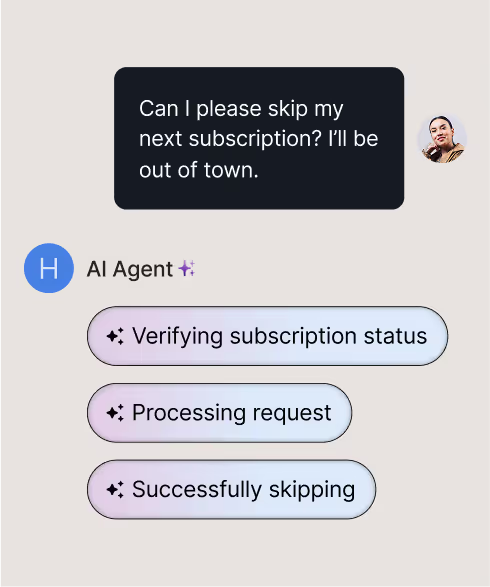
2. Add Shopping Assistant to drive revenue
While AI Agent, covers the support front, Shopping Assistant is your digital salesperson. It engages high-intent shoppers in real time, recommends the right products, and even upsells or cross-sells based on what the customer is browsing.
Whether it’s helping someone choose the perfect shade or nudging them to complete their cart, Shopping Assistant is designed to increase AOV and reduce abandonment.
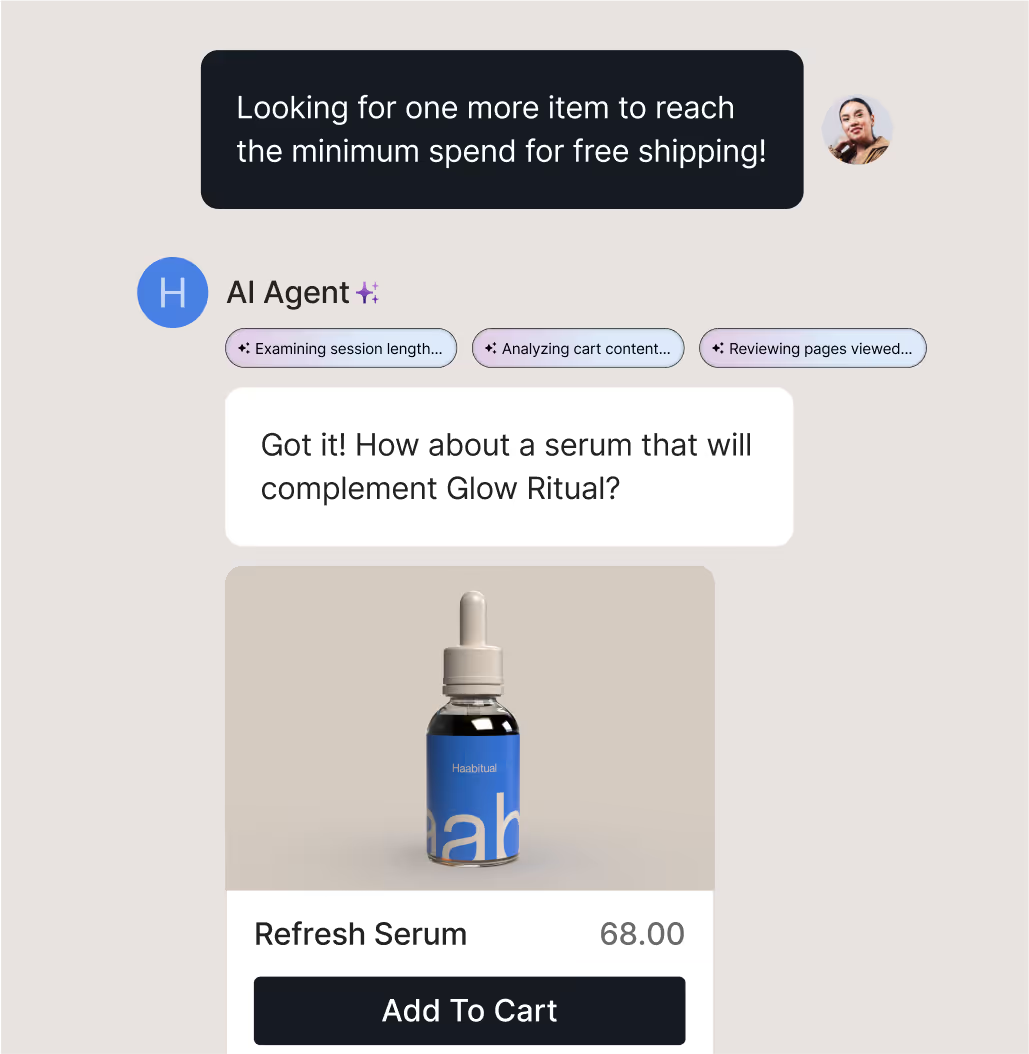
The future of ecommerce is conversational
Every time a shopper lands on your site, scrolls through Instagram, or replies to a shipping update, they’re opening the door to a conversation. The brands that show up quickly, helpfully, and with the right message, are the ones winning loyalty and revenue.
With AI Agent, you can automate accurate responses to common questions, giving your team time back without sacrificing customer experience. And with Shopping Assistant, you can turn those conversations into conversions, offering personalized recommendations, upsells, and discounts based on shopper intent.
You don’t need a massive team or months of setup to start. Just the right tools, and a strategy built for your customers.
Book a demo and learn how Gorgias helps you turn every conversation into an opportunity to grow.
{{lead-magnet-2}}
Newsletter Signup
The best in CX and ecommerce, right to your inbox
Featured articles
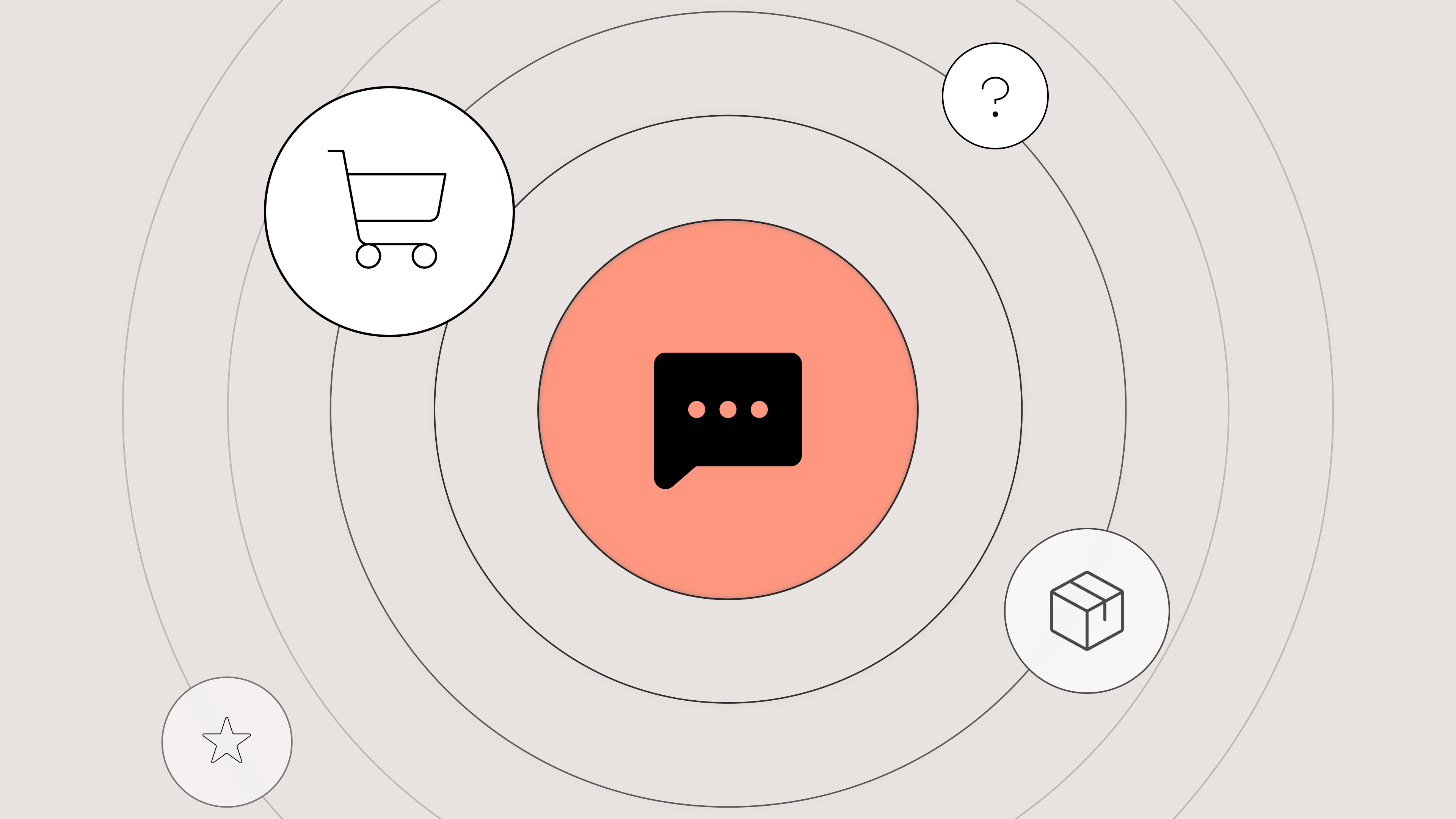
Should You Offer Live Chat Support? A Guide for CX Teams
TL;DR:
- Live chat is the fastest way to help shoppers. It gives customers real-time answers and prevents drop-off.
- You don’t need a 24/7 team to run live chat. Automate FAQs and set clear hours to keep it manageable.
- Live chat improves conversions and customer loyalty. Shoppers who chat are more likely to make a purchase and return to your store.
- Start by automating questions like order tracking and returns. These are easy to answer and make up most of your volume.
- Gorgias makes it easy to launch and scale live chat. You can integrate with your store and go live in under a day.
According to 2025 Gorgias data, chat inquiries are resolved in 24 minutes versus two days on email. It’s no wonder customers prefer live chat over any other support channel.
If you aren’t already offering live chat, it might feel like a big commitment. But when the end product is happier customers, it’s high time to catch up.
Thinking about offering live chat? Learn more about the benefits of live chat customer support, how it differs from chatbots, when and how to use it, and the best live chat tools to use based on your team’s needs.
What is live chat support?
Live chat support is a form of customer service that uses a chat widget to intake customer inquiries. Ecommerce websites, browser-based tools, and mobile apps typically offer live chat in combination with other customer service channels like email, phone, and social media.
Depending on the business, live chat support availability can vary. Some businesses choose to run live chat within their operating hours, while others extend 24/7 availability with the help of automation, conversational AI, or a dedicated off-hours team.
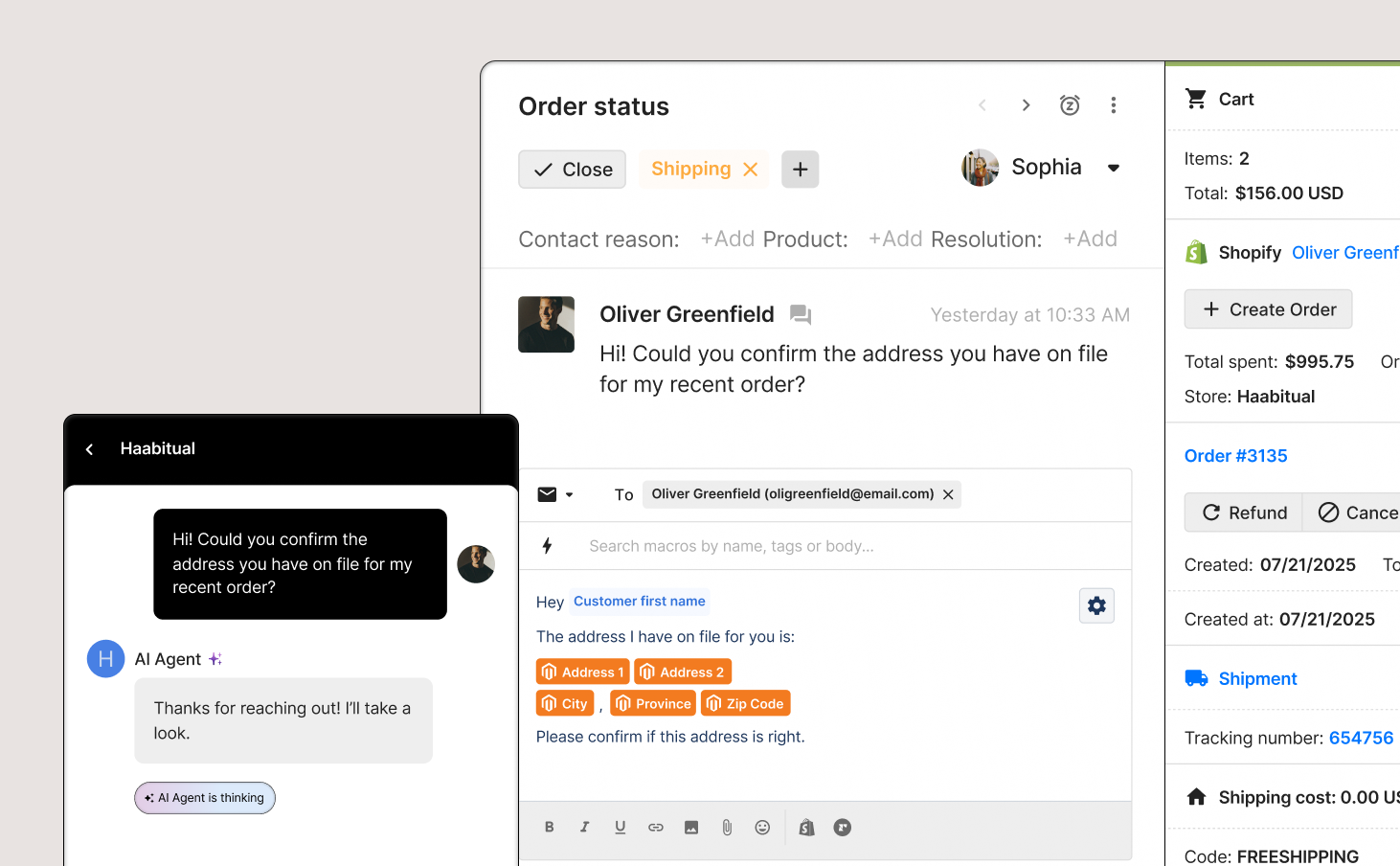
Related: Customer service messaging: Tips and templates for SMS + conversational channels
How does live chat support differ from a chatbot?
The main difference between live chat and chatbots is the option to speak to a live human agent.
With live chat support, customers always have the option of speaking to a live human agent. Meanwhile, chatbots can only provide customers with automated responses, whether preconfigured or generated by AI.
Why should you offer live chat support?
Live chat doesn’t just make support faster—it helps you close more sales.
Aside from quick answers, customers want confidence to buy. In fact, Hiver reports that 63% of consumers prefer live chat over phone and social media, mainly because they get instant answers while they’re still browsing.
Here are the benefits of implementing live chat for your business:
- Customer satisfaction: Customers get the clarity they need while shopping
- Higher conversions: Live chat removes friction at checkout by resolving doubts in real time
- Faster resolutions: Support teams close tickets faster by solving issues right away
- Revenue retention: Agents can recommend the right product, reducing the chance of returns later
Read more: A guide to resolution time: How to measure and lower it
When does live chat make the biggest impact?
Live chat shines in situations where timing directly impacts whether a customer buys your product or walks away. These conversations often happen before a purchase, like when a shopper is deciding between products, has concerns about shipping, or wants to confirm your return policy.
Use live chat in these moments:
|
Moment |
Why Live Chat Works |
|---|---|
|
Before a purchase |
Provides instant product education, assurance, and curbs hesitation due to a lack of information |
|
Order-related concern |
Resolves time-sensitive questions on shipping or changes before the customer bounces |
|
Checkout hesitation |
Reduces cart abandonment by addressing doubts |
|
FAQs |
Deflects repetitive tickets through automation, freeing agents for complex conversations |
|
High-value customers |
Offers high-touch service that reinforces loyalty and drives repeat purchases |
|
Bulk orders |
Accelerates large sales by delivering clarity when urgency is high |
How automation makes live chat support scalable
You don’t need a large support team to offer high-quality live chat support. Sure, live chat can feel risky if you’re a brand with a lean CX team or high ticket volume, but when you automate the right types of conversations, it becomes one of the most impactful support channels.
What to automate first
Start with high-frequency, low-complexity inquiries. These are repetitive questions that don’t require an agent to resolve:
- Order tracking (where is my order)
- Shipping, return, exchange, and cancellation policies
- Basic troubleshooting
- Product education, like sizing or fit guides
These types of tickets typically make up the bulk of your live chat volume. Automating them clears the way for agents to focus on conversations that require more specialized knowledge and nuance.
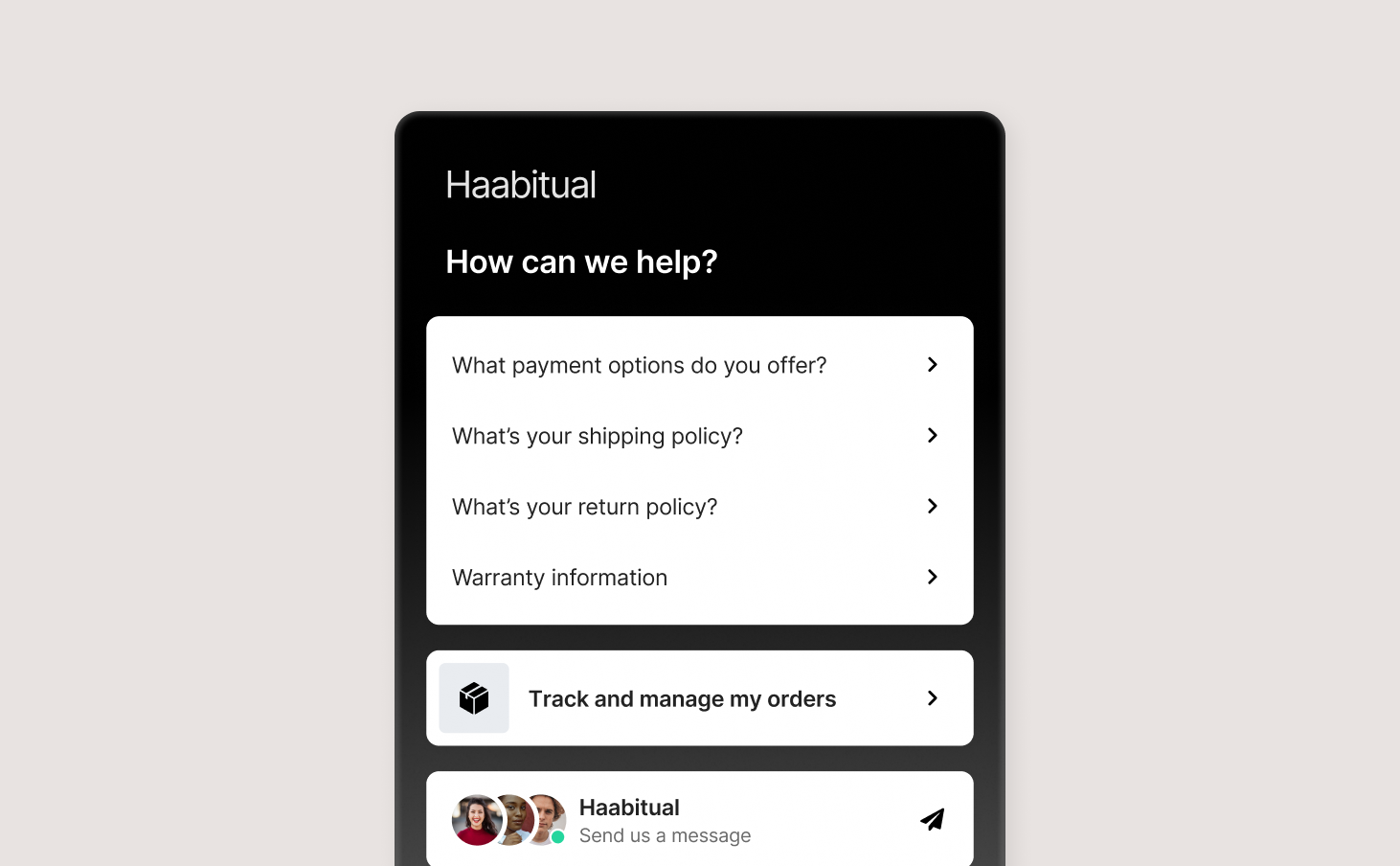
Automation features that help you scale
The best live chat isn’t only a messaging tool, it also comes with features that make the support agents using it more productive.
Here are the top automation features to improve live chat:
- Macros: One-click prewritten replies to common questions that agents can send manually or automatically.
- Customer and product variables: Dynamic details—like name, order number, and delivery date—pulled from your ecommerce platform and inserted into messages can easily make interactions more personalized.
- Flows: Interactive Q&A scenarios that automatically answer customer questions in the chat widget.
- Routing: Prioritize or assign tickets to agents based on topic, urgency, or language for maximum efficiency.
- Conversational AI: Leave live chat on 24/7 with tools like Gorgias AI Agent to answer repetitive questions and update orders—even when your team is offline.
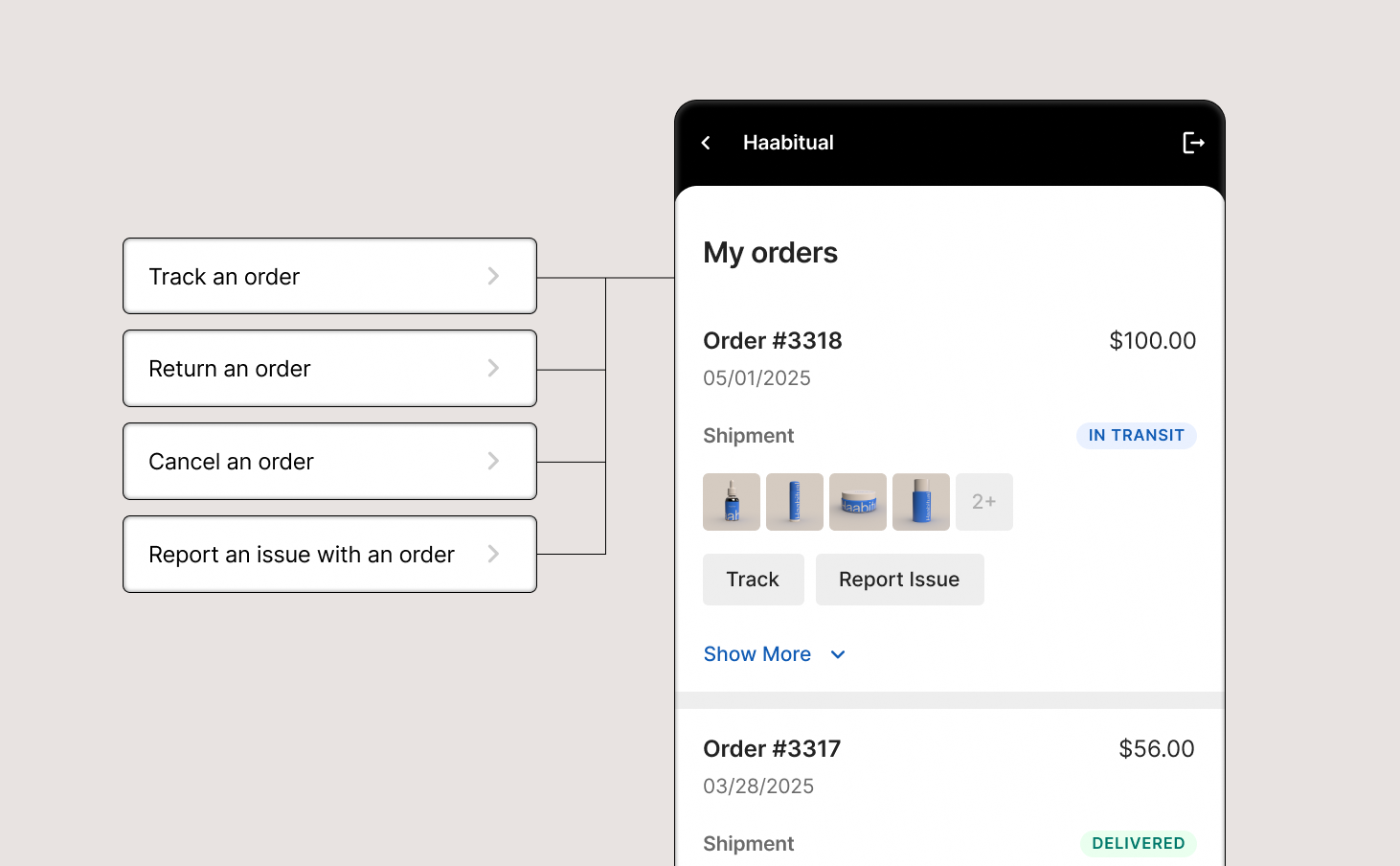
The dos and don’ts of replying to a live chat message
Good live chat messages are quick, helpful, and easy to follow. Poor live chat messages are slow, robotic, or long-winded.
Follow these guidelines to help keep your replies effective and consistent:
|
Do ✅ |
Don’t ❌ |
|---|---|
|
Respond within your target SLA |
Leave customers waiting |
|
Keep responses concise |
Send long, wordy messages |
|
Use macros and templates as a starting point |
Manually type everything again and again |
|
Ask clarifying questions |
Assume you understand everything |
|
Be transparent if you need more time |
Promise something you can’t deliver |
|
Confirm resolution before ending the conversation |
End the chat without checking if the issue is solved |
How to set up live chat without overwhelming your team
Adding live chat for the first time or want to make your current setup more manageable? Start with these five steps:
1. Set live chat hours
You don’t need to be online at all times to offer live chat. Start by choosing live chat hours that reflect your team’s availability and peak shopping hours.
Remember to display your availability on your website clearly to manage customer expectations.
2. Prioritize live chat tickets in your inbox
Customers who reach out to you via chat are active on your site and often close to purchasing.
Create rules in your helpdesk that flag live chat conversations as urgent, so they don’t get buried under slower channels like email. If you have a dedicated agent who handles chat, route all chat tickets to them for instant visibility.
3. Automate your first reply
Set up an auto-response that triggers immediately when someone starts a chat. Even a short message like “Hey! Thanks for your message, an agent will be right with you,” can reduce drop-off and give your team time to prep.
4. Edit your macros for live chat
Templates that work in email may be too wordy in chat. Shorten your macros, simplify the tone, and make sure each response fits cleanly into a chat window. Use dynamic variables to pull in details like order number or shipping status without slowing down your agents.
5. Capture customer emails when live chat is offline
Customers don't stop having problems when your team clocks out. When someone tries to chat outside business hours, collect their email so an agent can follow up once your support team is back online.
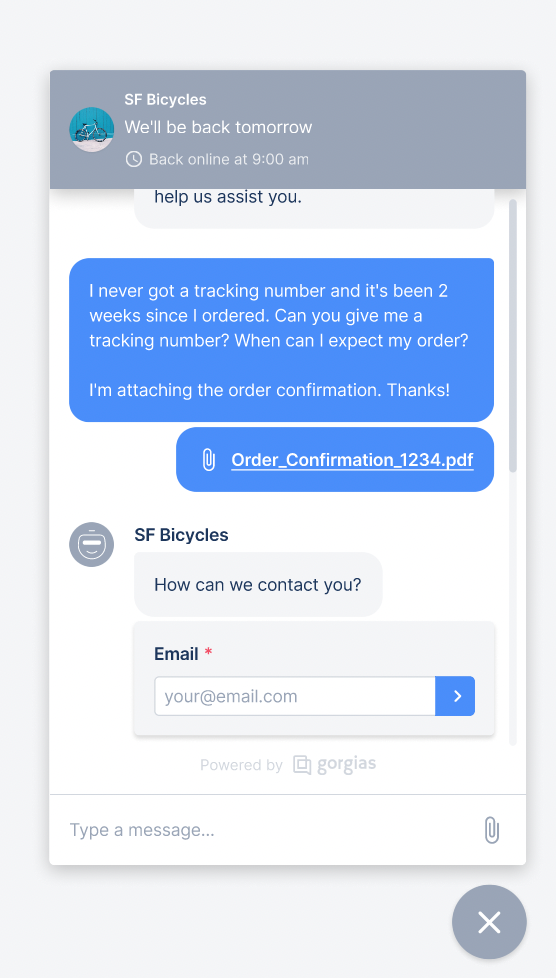
Best live chat tools for CX and support teams
If you’re evaluating live chat software, here are five solid options to start with. Each one fits different team sizes and priorities.
|
Tool |
Pricing Model |
Best For |
Standout Feature |
Limitation |
|---|---|---|---|---|
|
Gorgias |
Per ticket |
Ecommerce brands |
Conversational AI that handles support and drives sales with upsells, recommendations, and context-aware discounts |
Limited AI features for non-Shopify ecommerce stores |
|
Zendesk |
Per user |
Large CX teams with dev resources |
Highly customizable for large support orgs |
Built for general use, not ecommerce; limited email AI; high setup cost |
|
Intercom |
Per user |
SaaS and product companies |
Built-in onboarding and product messaging tools |
Not ecommerce-focused; limited integrations and high AI cost |
|
Tidio |
Per ticket |
SMBs looking for budget automation |
Affordable chatbot + live chat combo |
Lacks visual upsell tools and struggles with complex sales questions |
|
Richpanel |
Per user |
Early-stage teams |
Simple UI and fast time to launch |
Buggy UI, no AI Agent, slow updates, poor Shopify automation |
Deliver faster support without adding headcount
Gorgias helps ecommerce brands deliver fast support without cutting into your budget. Automate common questions with conversational AI, resolve tickets in seconds, support and sell, and give your team the context they need to handle complex conversations with one tool.
Want live chat that takes support to the next level? Book a demo.
{{lead-magnet-2}}
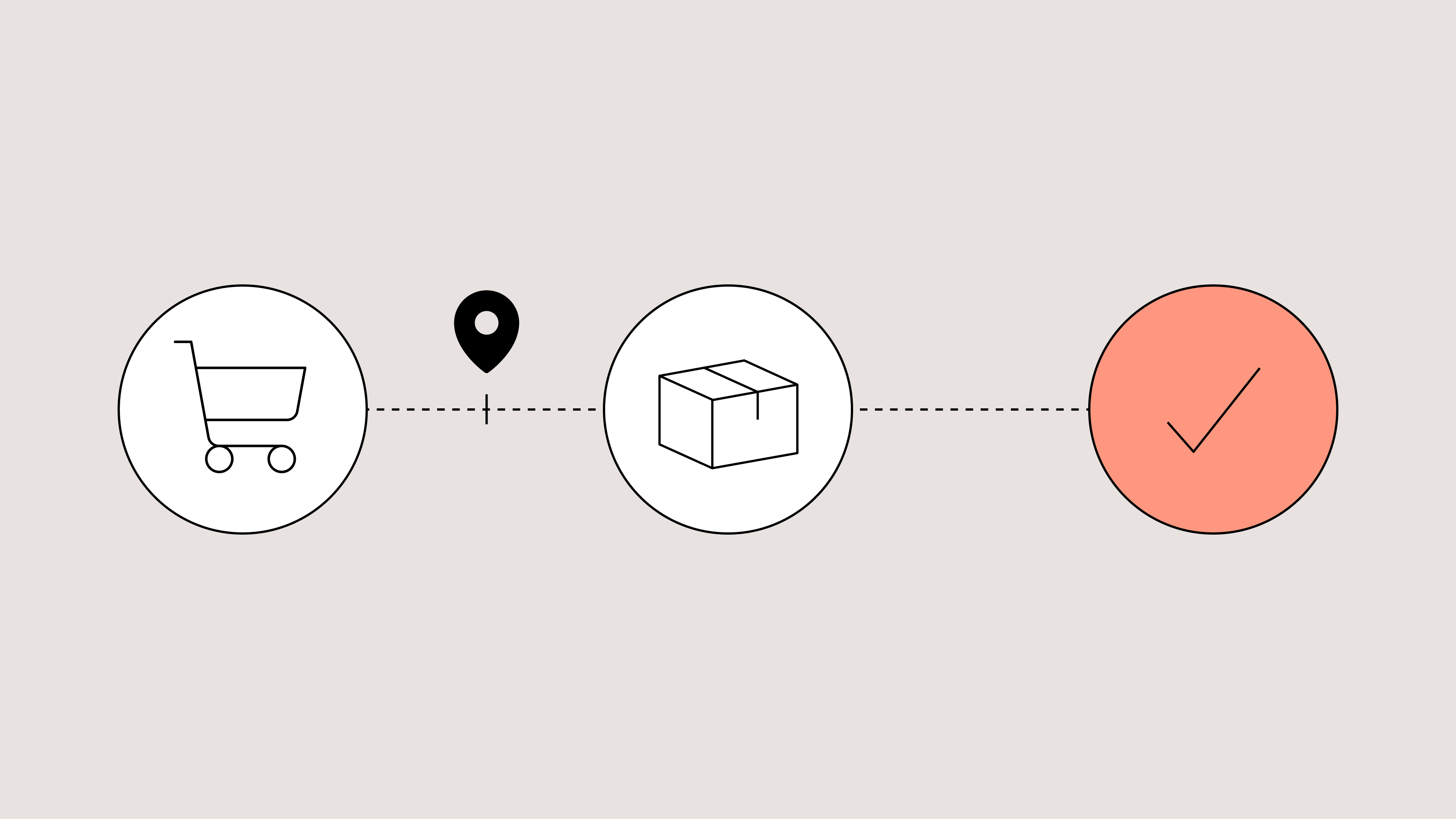
The Complete Guide to Tracking Customer Orders on Shopify
TL;DR:
- Customers expect real-time order tracking. Allow customers to track their orders from anywhere—from their email to your website—at any time to increase their sense of security, reduce returns, and build trust.
- Helpdesk + order tracking = efficient. Choose a solution like Aftership, ShipBob, or ShipStation that integrates with your CX platform. This lets you link shipping data with your customer data, resulting in faster support.
- Offer self-service tracking options. Ensure your shipping information is easily accessible to customers through email, live chat, SMS notifications, and on your website.
Today, order visibility is table stakes. Around 50% of consumers actively track their order status to confirm it's progressing smoothly and staying on schedule.
Whether it’s order anxiety or excitement, shoppers want to see their order's status and location at any given time. Even better when they can get real-time alerts via SMS or at each point in an order’s journey.
So if you haven’t set up order tracking yet, now’s the time, because your customers already expect it. Here’s everything you need to know about the benefits of tracking customer orders and how to implement an order tracking tool for your Shopify store.
{{lead-magnet-1}}
Why is order tracking so important for ecommerce?
Ecommerce vendors like Amazon have normalized order tracking. Today, most, if not all, customers expect to know where their order is.
Offering real-time tracking data for orders benefits both your customer and your business in five distinct ways:
- Peace of mind: Real-time tracking reassures shoppers and helps businesses monitor fulfillment.
- Fewer support tickets: Cuts down WISMO inquiries (18% of tickets) with automated updates.
- Lower returns: Accurate timelines reduce late-delivery returns and protect revenue.
- Stronger loyalty: Reliable tracking builds trust. Late or incorrect deliveries push shoppers away.
- Easy planning: Consumers need to know that an order is on its way to plan their day.
Recommended reading: Ecommerce returns: 10 best practices for taking your online store to the next level
How to set up order tracking for your Shopify store
Here’s how to set up order tracking for Shopify stores:
- Choose an order tracking tool
- Integrate your order tracking tool with Shopify
- Configure your order tracking app’s settings
- Integrate your order tracking app with your CX platform
As an example, we’ll show you how to set up order tracking on a Shopify store with AfterShip Tracking.
1) Choose an order tracking tool
First, choose an order tracking tool like ShipBob, ShipStation, or AfterShip. These tools pull order information, tracking numbers, and shipment status to generate shipping updates for your customers.
Pro Tip: It’s best if your order tracking app integrates with your helpdesk, so that you can offer faster, context-rich customer support.
Read more: 12 best shipping software tools for ecommerce stores
2) Integrate your order tracking tool with your ecommerce platform
Install your order tracking app of choice via the Shopify App Store. For us, it will be AfterShip Tracking.
To complete the integration, go to the AfterShip Tracking dashboard. Click Apps > View more apps > Shopify > Install app. You’ll be redirected to your Shopify settings. Read through the privacy and permission details and click Install app.
Pro Tip: Not sure if you did it correctly? Your store URL will be labelled as “Connected” on the Shopify connection page.

3) Configure your order tracking app’s settings
Time to load your order tracking app with your Shopify data. This is a crucial step to ensure your app uses your courier and order details.
On Aftership Tracking, go to Apps > Store connections > Actions to set up these two actions:
- Courier Mapping: This matches shipping company names between Shopify and AfterShip so tracking data flows correctly even when the same carrier has different names in each system.
- Auto-import settings: This controls which orders automatically sync from Shopify to AfterShip based on criteria like date range, payment status, and fulfillment status, so you only track the orders you want.
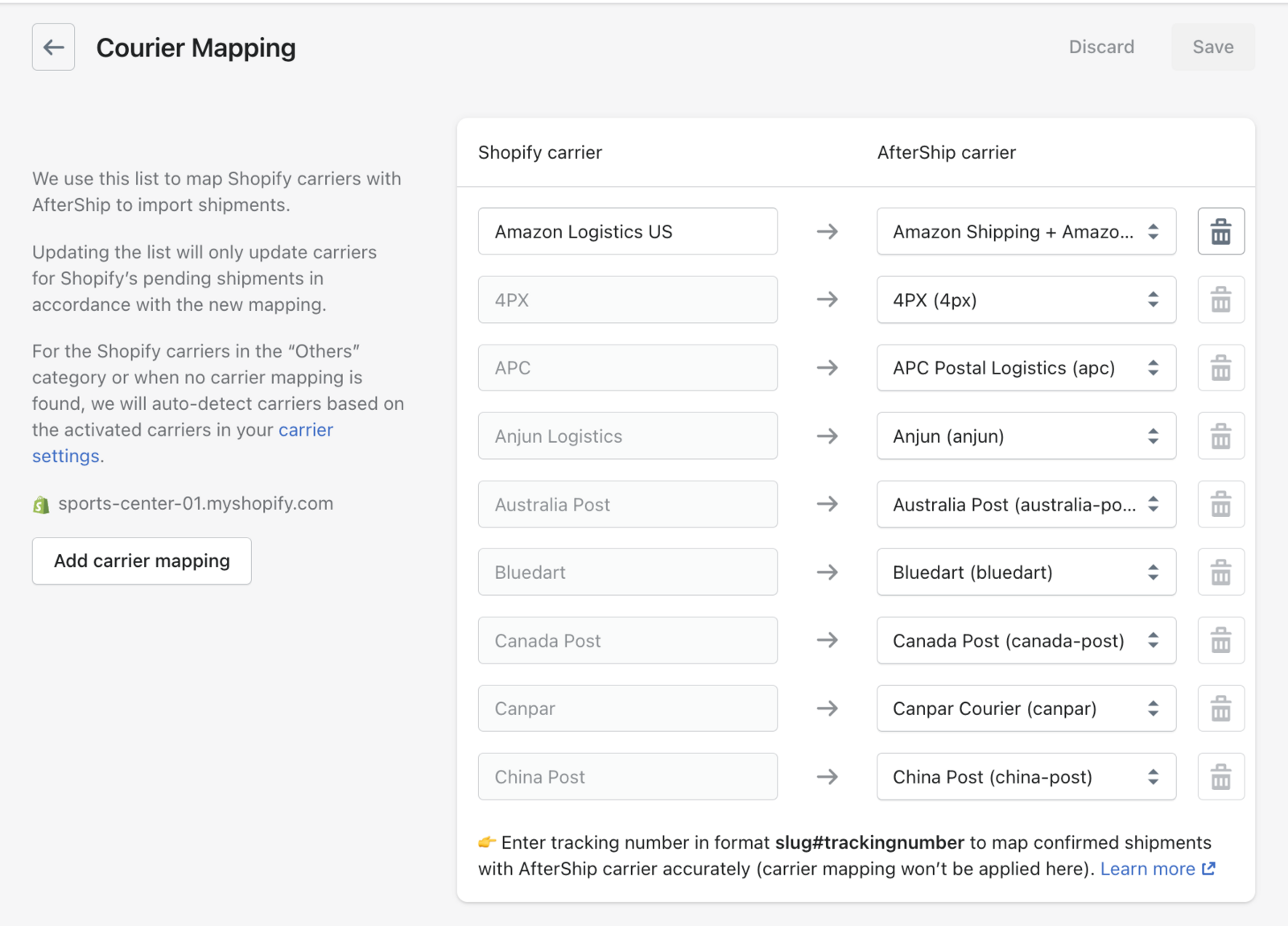
4) Integrate your order tracking app with your CX platform
Finally, connect your order tracking app to your helpdesk.
When customer messages, shipping data, and tracking information are connected, your team can:
- Get the full context with instant access to tracking numbers, shipping addresses, and estimated delivery dates
- Eliminate the need to switch tabs or copy/paste information between tools
- Resolve customer inquiries faster
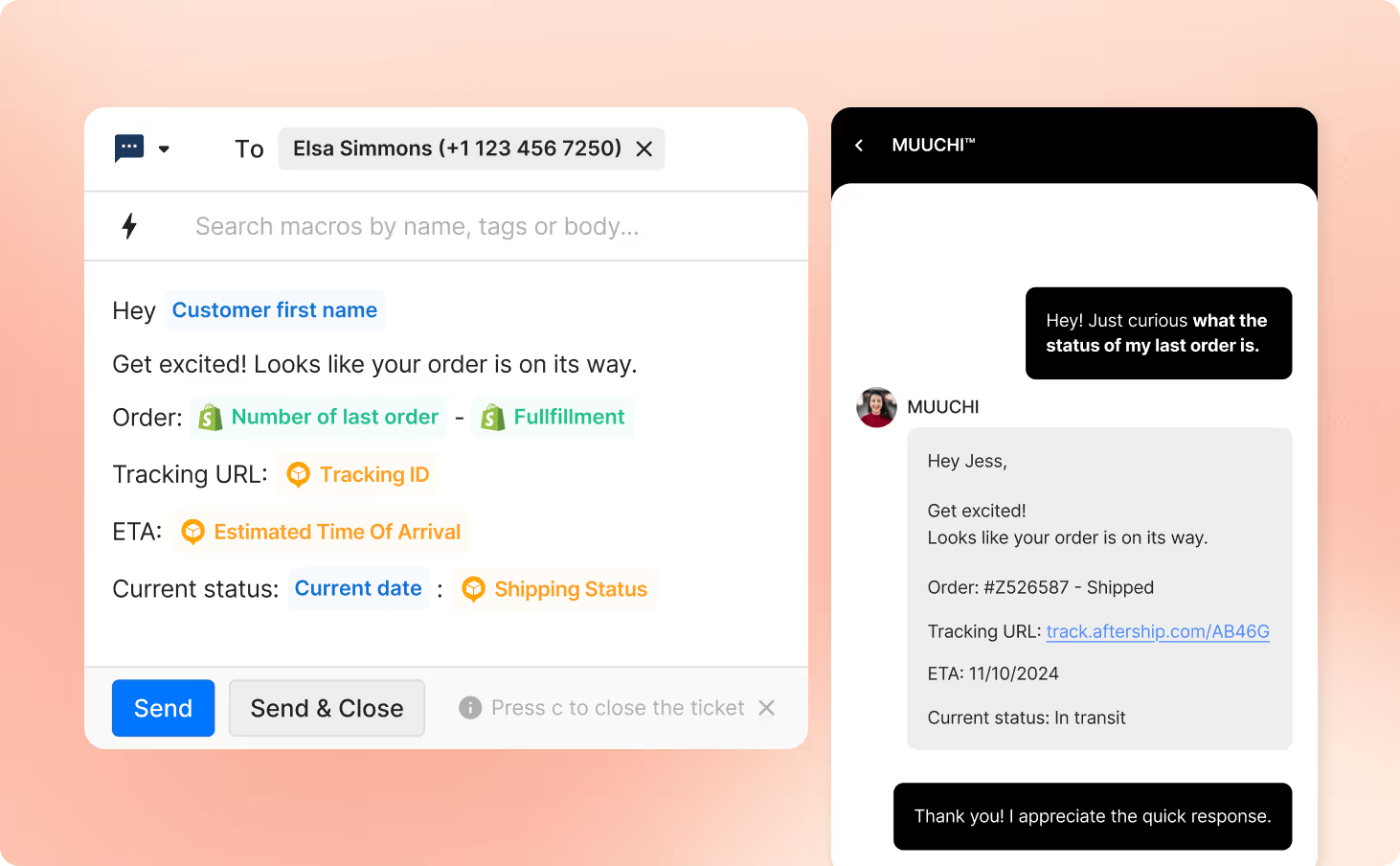
Read more: How to connect AfterShip Tracking to Gorgias
The 6 key spots to add ‘Track My Order’
It’s important to make order tracking accessible to customers, wherever they are. And since more than 68% of orders are done through smartphones, it’s critical to design every tracking touchpoint with a mobile-first experience in mind.
Order tracking should be available in:
- Emails (order confirmation and automated replies): Include the receipt, tracking number, and a link to the tracking portal. Automated replies should also provide updates when customers ask about order status.
- SMS: Send the tracking number and portal link. Use for delivery updates, delays, or exceptions.
- Conversational AI in chat: Provide the order status, tracking number, and delivery estimate directly in the response.
- Self-service order management: Add a “track my order” button in the chat widget with order status, tracking number, and delivery date.
- Help Center (FAQ page): Embed a tracking tool where customers can enter their order number or email to see status and carrier tracking.
- Account portal: Show fulfillment status, tracking number, and carrier link in the “My Account” section for each order.
What are the best order tracking apps for ecommerce stores?
Depending on your needs and the ecommerce platform you use, choose from options that are both scalable and flexible.
ShipBob
ShipBob is a global logistics platform that helps ecommerce brands provide fast, affordable shipping and best-in-class order fulfillment. Its connected technology and fulfillment network improve delivery times, reduce costs, and elevate the customer experience.
Standout features:
- Distributed global fulfillment centers shortens delivery times
- Real-time inventory management and order tracking
- Affordable shipping rates through carrier partnerships
- Analytics tools to optimize fulfillment and logistics performance
Check out ShipBob in the Shopify App Store or the BigCommerce App Store.
AfterShip
AfterShip is a shipment tracking and notification platform that helps ecommerce brands keep customers informed and improve delivery transparency. It streamlines post-purchase communication and makes it easier to spot delivery issues before they affect customer experience.
Standout features:
- Seven customizable notification triggers (e.g., in transit, out for delivery, delivered)
- Easy-to-use email editor for branded tracking updates
- Filter and monitor tracking data to detect delivery issues early
- Branded tracking pages that keep customers on your site
- Detailed analytics to measure delivery performance and customer engagement
Check out AfterShip in the Shopify App Store and the BigCommerce App Store.
ShipStation
ShipStation is a shipping software solution that helps ecommerce businesses save time and money by comparing carrier rates and delivery times in one place. It automates shipping workflows to ensure customers get fast, cost-effective delivery.
Standout features:
- Compare rates and delivery speeds across multiple carriers
- Automate shipping processes, from label creation to returns
- Intuitive dashboards and user-friendly interfaces for efficient workflows
- Batch processing for high-volume order fulfillment
- Branded shipping labels, packing slips, and tracking pages
Check out ShipStation in the Shopify App Store and the BigCommerce App Store.
ShipMonk
ShipMonk is a third-party logistics (3PL) provider that helps ecommerce businesses scale with fast, affordable fulfillment services. Its technology-driven platform streamlines order, inventory, and warehouse management to deliver a seamless post-purchase experience.
Standout features:
- Distributed fulfillment centers for faster, lower-cost shipping
- Real-time inventory and order management
- Automated picking, packing, and shipping workflows
- Scalable solutions tailored for ecommerce, subscription boxes, crowdfunding, and more
- Detailed reporting and analytics to optimize logistics
Check out ShipMonk in the Shopify App Store.
Easyship
Whether you ship 50 or 50,000 orders a month, Easyship can help you lower shipping costs and increase conversion rates. Use this extension to manage your post-purchase process in the most efficient way for your business.
Read more about Easyship in the Magento Marketplace.
Recommended reading: 12 best shipping software for ecommerce
Mageworx
The Mageworx Order Editor extension lets you edit customer errors. Quickly fix any mistakes customers make during checkout like incorrect street numbers, phone numbers, names, shipping, or billing details.
You can also add or remove products, change pricing, and add coupons after an order has been placed. This saves your customer support team from having to cancel the order and start it again from the beginning.
Learn more about Mageworx Order Editor in the Magento Marketplace.
Simplify order tracking with Gorgias
Use Gorgias to centralize order tracking, automate status updates, and deliver real-time delivery info, all in one place. By deflecting repetitive WISMO tickets, your team saves time, boosts CSAT, and focuses on higher-value conversations that drive retention and revenue.
Book a demo to see how Gorgias integrates with your order tracking system.
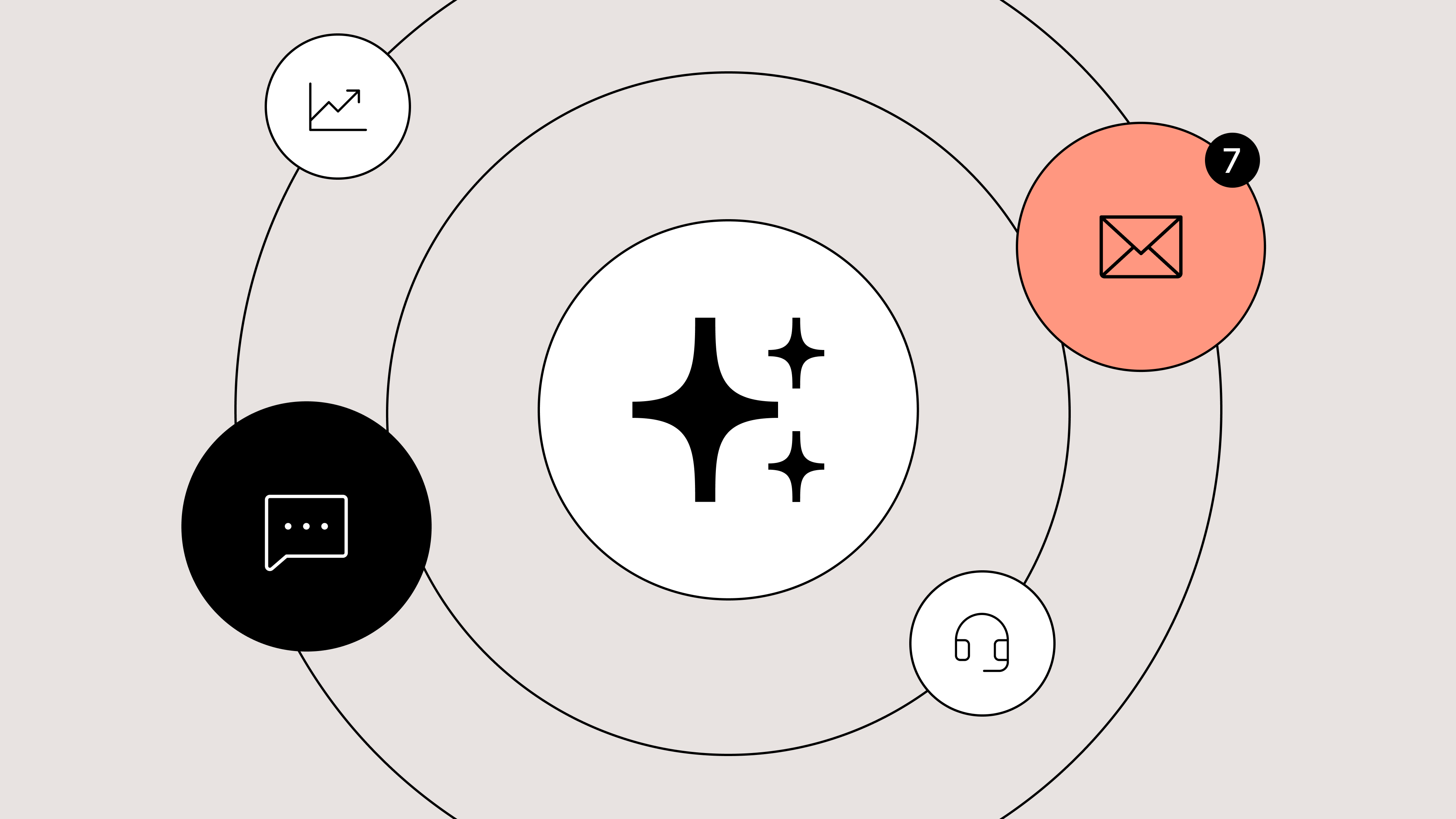
Best AI Helpdesk Tools: 10 Platforms Compared
TL;DR:
- The best AI helpdesks offer smart ticketing, self-service, and sales automation. They combine multi-channel support, give teams flexible AI control, and double as an upselling tool that drives revenue.
- Each tool has a unique strength. Gorgias is best for ecommerce brands , Zendesk offers enterprise-level customization, Intercom is great for SaaS engagement, and Tidio is easy for small teams.
- There are also standalone AI tools that integrate with existing helpdesks. Platforms like Ada, Siena, and Yuma offer automation without requiring a full platform switch.
- Advanced AI features vary in price and availability. Some are bundled, while others charge per resolution or limit access to higher tiers.
Every delayed reply, missed ticket, or frustrated customer costs more than just satisfaction—it hits revenue, loyalty, and your brand reputation. That’s why more and more brands are investing in AI helpdesks to automate the tedious parts of their job.
But with so many options on the market, choosing the right AI helpdesk can feel overwhelming. Should you prioritize conversational AI? Multi-channel support? No-code customization? Or pricing that scales with your team?
{{lead-magnet-1}}
We’ve reviewed the 10 best AI helpdesks available in 2025, evaluating them across AI capabilities, ease of use, integrations, analytics, and pricing.
Helpdesk |
AI Features |
Main Strength |
Potential Limitation |
Best For |
Starting Price |
|---|---|---|---|---|---|
Gorgias |
AI Agent, Shopping Assistant, Auto QA |
Multi-channel ecommerce support, AI shopping assistant |
Ecommerce-focused |
Scaling and enterprise ecommerce brands |
$10/month per agent |
Zendesk |
Copilot, AI triage, Zendesk QA |
Enterprise-grade omnichannel support |
Can be complex for smaller teams |
Large enterprises like banks and airlines |
$25/month per agent |
Intercom |
Fin AI, Fin Tasks, Fin Insights |
Conversational AI, proactive support |
Higher learning curve for complex workflows |
SaaS and mid-to-large businesses |
$39/month per agent |
Gladly |
Gladly Hero, Sidekick Chat, Sidekick Voice |
Conversation-centric support, loyalty focus |
Complex implementation onboarding process |
Customer-focused businesses that prioritize loyalty |
Custom pricing |
Kustomer |
AI Agents for Reps, AI Agents for Customers |
CRM-centric support |
Unintuitive and laggy user interface |
Mid-to-large enterprises |
$89/month per agent |
Tidio |
Lyro AI Agent |
Easy-to-use automation for small teams |
May not scale for large enterprise workflows |
Small to mid-sized ecommerce/service businesses |
Free, $29/month per agent |
Freshdesk |
Freddy AI |
Affordable multi-channel support |
Advanced AI limited to higher tiers |
SMBs and mid-market companies |
$18/month per agent |
Ada |
Ada Voice, Ada Email |
Self-service chat automation |
Basic features cost extra |
Large enterprise businesses |
$499/month |
Siena |
Customer Service Agent, Reviews Agent, Siena Memory |
Automated support |
Lack of visibility into support and AI performance |
Mid-market ecommerce and SaaS |
$500/month |
Yuma |
Support AI, Sales AI, Social AI |
Self-service & automation for growing teams |
Limited integrations with broader sales stacks |
Established ecommerce brands |
$49/month per agent |
How we evaluated the best AI helpdesks in 2025
To create this list, we evaluated each platform based on a combination of functionality, AI capabilities, usability, and industry applicability.
Our goal was to provide a resource that CX leaders, ecommerce managers, and support teams can rely on when choosing a helpdesk that fits their business needs.
Here’s how we approached the evaluation:
- Feature set assessment: Each tool was reviewed for its core helpdesk features, including ticket management, multi-channel support, workflow automation, and reporting capabilities.
- AI sophistication: Platforms were evaluated on the depth of their AI offerings. This included natural language processing (NLP), predictive analytics, proactive messaging, and automated resolution capabilities.
- Ease of use and setup: We considered setup time, onboarding complexity, and the learning curve for both agents and admins.
- Industry applicability: We examined which industries each tool serves best. Some platforms are tailored for ecommerce, while others are more enterprise or service-focused.
- Pricing transparency and scalability: We noted starting costs, AI feature availability by tier, and potential scaling considerations. Affordability and scalability were important, particularly for fast-growing teams that need to balance cost with AI functionality.
- Supporting resources: We reviewed customer support, integrations, documentation, and community resources. A strong helpdesk not only provides AI features but also ensures teams can implement and optimize them effectively.
By following this methodology, we created a balanced, objective view of each helpdesk, highlighting what makes them unique, their strengths, limitations, and who will benefit most from them.
The best AI helpdesks of 2025
Gorgias
Gorgias is an AI helpdesk designed for ecommerce brands, helping teams streamline support while boosting both efficiency and personalization.
By unifying all customer touchpoints—email, chat, social media, voice, and SMS—into a single dashboard, Gorgias allows support teams to manage interactions without toggling between platforms.
Unlike most helpdesks, its AI capabilities go beyond basic automation. In addition to support, its AI can influence sales by assisting, recommending, and upselling to customers based on their shopping behavior.
Best for: Scaling startups and mature ecommerce enterprises looking to expand support capacity without increasing headcount
Potential limitations: Gorgias is focused primarily on ecommerce brands, which means it may be less suitable for companies that don’t use ecommerce platforms.
Pricing: Starts at $10/month, with advanced AI features available as an add-on.
Main features:
- Automated ticket routing: AI triages incoming customer queries and assigns them to the right agent.
- AI-generated responses: Provides instant, context-aware replies to common questions.
- Sentiment analysis: Flags frustrated customers to prioritize urgent tickets.
- Multi-channel AI support: Integrates across email, chat, Shopify, social media, and 100+ ecommerce apps.
- Macros and workflow automation: AI suggests relevant responses and automates repetitive tasks.
AI features:
- AI Agent: Conversational AI that can update, refund, and replace orders, cancel/skip subscriptions, and even carry out custom-made actions.
- Shopping Assistant: A proactive AI tool that guides, upsells, and recommends products to shoppers through chat. It helps CX teams increase sales and AOV.
- Auto QA: Upgrades service quality by automatically evaluating 100% of private text conversations, whether handled by a human or AI. Each message is scored on metrics like Resolution Completeness, Brand Voice, and Accuracy.
Zendesk
Zendesk is a widely adopted AI helpdesk solution that caters to teams of all sizes, from small businesses to large enterprises. It’s known for its robust ticketing system, extensive integrations, and customizable workflows, making it a versatile choice for teams across industries.
Best for: Non-ecommerce enterprises and businesses like airlines and banks
Potential limitations: Advanced AI features and enterprise-level plans can be expensive for smaller teams, and some users report that customization for niche workflows can be time-consuming.
Pricing: Starts at $25/month per agent, with advanced AI features and enterprise options available on higher tiers.
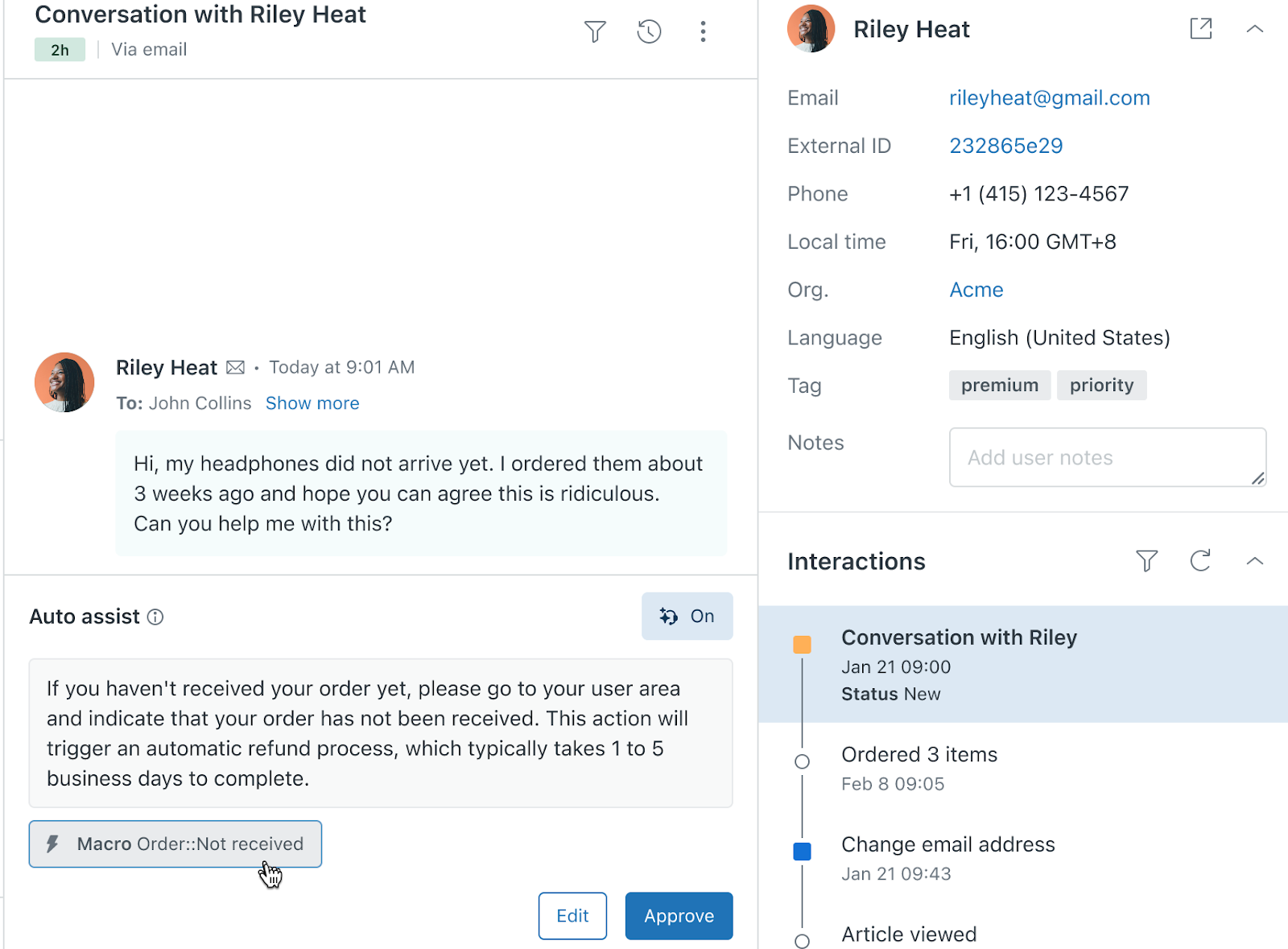
Main features:
- Unified ticketing: Centralizes requests from email, chat, phone, social media, and messaging apps.
- Macros and workflow automation: Automates routine responses and processes to reduce agent workload.
- Advanced analytics: Offers real-time dashboards and reporting to track support performance and customer satisfaction.
- Multi-channel support: Integrates seamlessly with major ecommerce, CRM, and communication platforms.
AI features:
- Copilot: Assists support agents in providing consistent replies, suggests next steps, and can even perform actions on agents’ behalf.
- AI triage: Automatically categorizes tickets and routes them to the appropriate team member.
- Zendesk QA: Scores the quality of interactions to help you get an overview of support performance.
Intercom
Intercom combines live chat, messaging, and AI automation into a single platform that focuses on proactive customer engagement. Its conversational AI makes it easy for teams to interact with customers in real time, while its automation tools help reduce response times and increase efficiency.
Best for: SaaS companies, software companies, and mid-market teams
Potential limitations: Companies looking for a plug-and-play AI solution will need to invest time in setting up Intercom. Customers report a steep learning curve when creating workflows, organizing users, and implementing new automations.
Pricing: Starts at $39/month per seat. Fin AI is available as a standalone product for $0.99 per resolution (50 resolutions per month minimum) if you have an existing helpdesk.
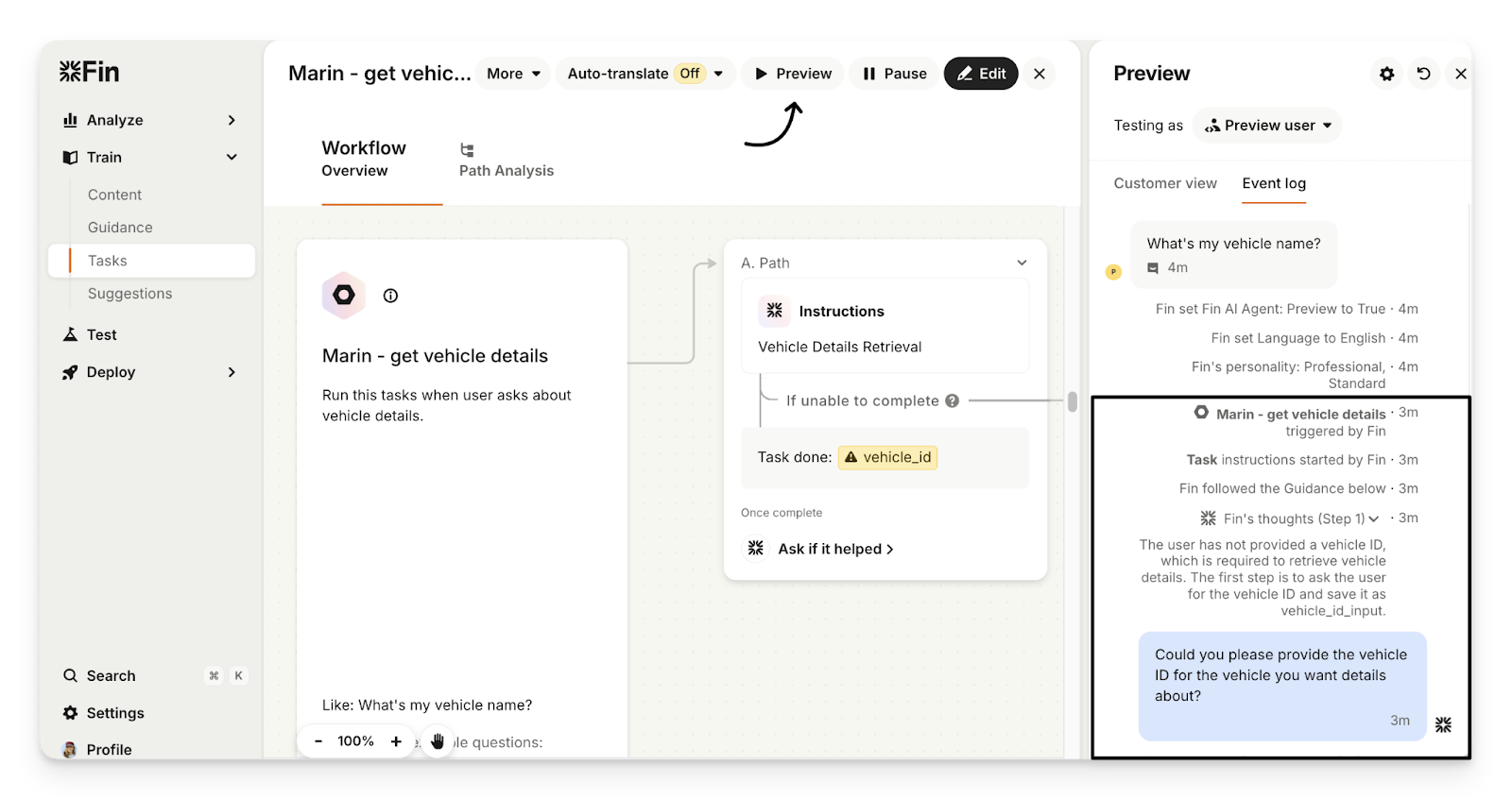
Main features:
- Live chat and messaging: Provides instant support via website, mobile apps, and email.
- Inbox and workflow management: Centralizes customer conversations and automates repetitive tasks.
- Customer segmentation: Enables targeted messaging based on behavior, subscription plans, or engagement levels.
AI features:
- Fin AI: Intercom’s AI assistant responds to common questions, freeing agents to handle complex issues.
- Fin Tasks: Performs actions like retrieving order details, processing refunds, reorders, and more.
- Fin Insights: Provides a deep look into recurring trends and issues across conversations.
Gladly
Gladly is a customer service platform built around the concept of conversation-centric support, treating every customer interaction as a continuous dialogue rather than isolated tickets.
Best for: Customer-focused brands that prioritize personalized, ongoing conversations over transactional support—especially retail, financial services, and subscription businesses that want to strengthen loyalty.
Potential limitations: Smaller teams may find it more than they need, and advanced customization can require professional services.
Pricing: Available on request, with plans typically tailored to enterprise support teams and scaled based on users and features.
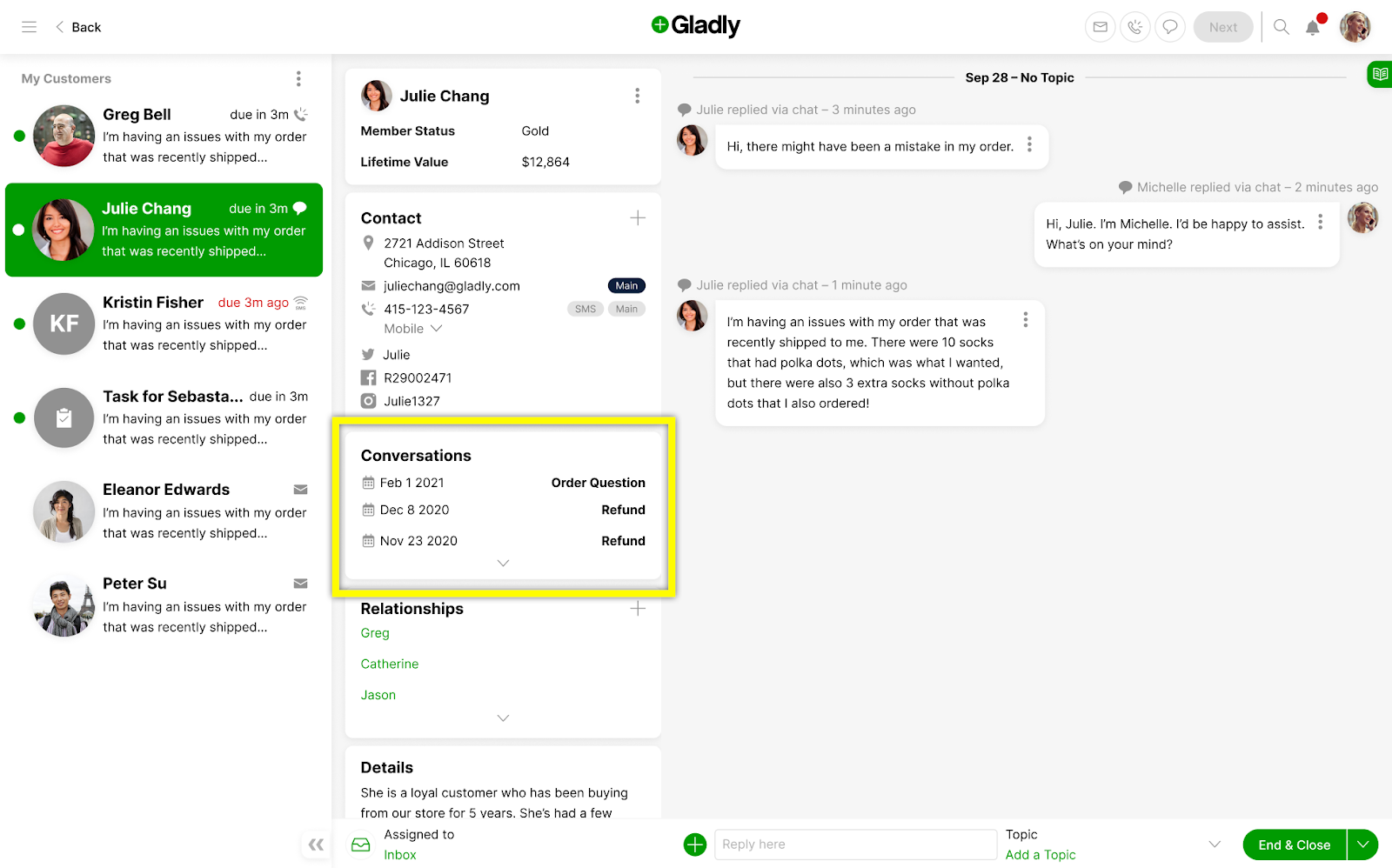
Main features:
- Unified customer timeline: Combines all interactions—email, chat, social, SMS—into a single, chronological view.
- Personalized workflows: Tailors automation and routing to individual customer needs.
- Team collaboration tools: Enables seamless handoffs and internal notes for faster issue resolution.
AI features:
- Gladly Hero: Customer profiles created from conversations that include preferences, relationships, and purchase history.
- Sidekick Chat: Instant answers to requests like returns, account updates, and refunds.
- Sidekick Voice: Real-time, AI-powered phone support with SMS follow-ups.
Kustomer
Kustomer is a CRM-centric AI helpdesk that integrates customer support and relationship management in one platform. Its AI capabilities allow teams to automate repetitive tasks, route tickets intelligently, and gain insights into customer history, making it ideal for businesses with complex support workflows.
Best for: Mid-to-large enterprises that prioritize powerful, custom reporting
Potential limitations: Users report an unintuitive and laggy interface, which can slow down large support teams that handle high support volumes.
Pricing: Starts at $89/month per seat, with AI features available as add-ons.
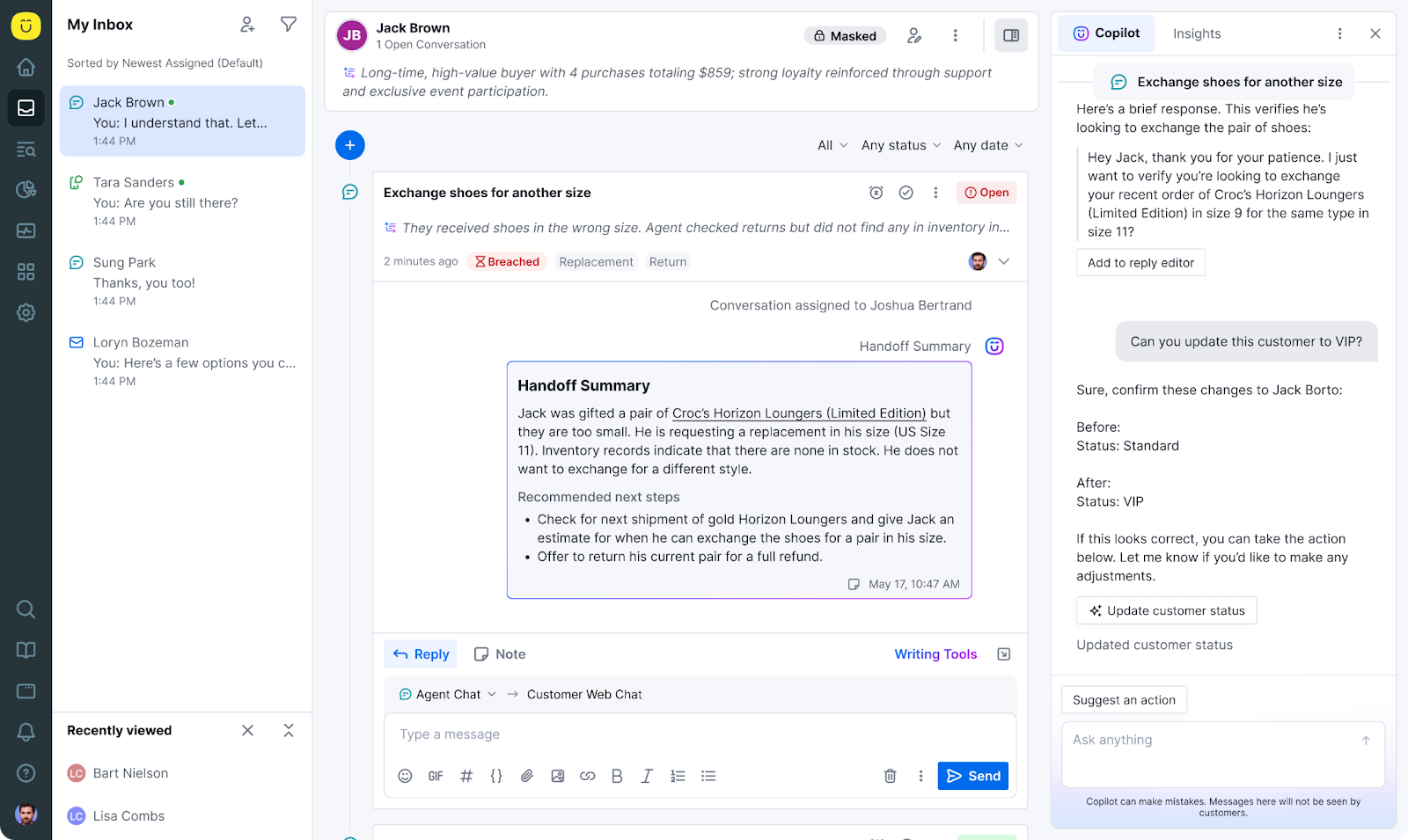
Main features:
- Unified customer profiles: Consolidates all interactions, purchases, and support history in one view.
- Workflow automation: Streamlines processes with rules-based ticket routing and escalation.
- Advanced reporting: Tracks key support metrics and agent performance.
AI features:
- AI Agents for Reps: Offers real-time assistance, from drafting responses to updating records and summarizing conversations.
- AI Agent for Customers: Allows the creation of multiple AI Agents for specialized tasks.
Tidio
Tidio is an AI-powered live chat and messaging platform built for small to mid-sized businesses looking to combine automation with personalized support. Its ease of setup and affordability make it a strong choice for teams new to AI helpdesks.
Best for: Small to mid-sized ecommerce or service-based businesses looking for an easy-to-use AI chat solution to automate FAQs
Potential limitations: May not scale well for large enterprise businesses.
Pricing: A free plan is available, with paid plans starting at $29/month per agent and AI features as add-ons.

Main features:
- Live chat and messenger integration: Supports website chat, email, and social messaging.
- Drag-and-drop chatbot builder: No coding required to deploy automated responses.
- Ticket management: Organizes queries for quick resolution by agents.
AI features:
- Lyro AI Agent: Conversational AI that answers questions based on support content.
Freshdesk
Freshdesk is a helpdesk platform that combines AI automation, omnichannel support, and workflow management. It’s known for ease of use and affordability, making it popular among SMBs and mid-market companies.
Best for: SMBs and mid-market companies looking for an affordable, easy-to-implement AI helpdesk
Potential limitations: Some advanced AI functionality is limited to higher-tier plans. Large enterprises may require additional configuration to fully leverage AI features.
Pricing: Plans start at $18/month per agent, with AI capabilities and advanced automation available on higher tiers.
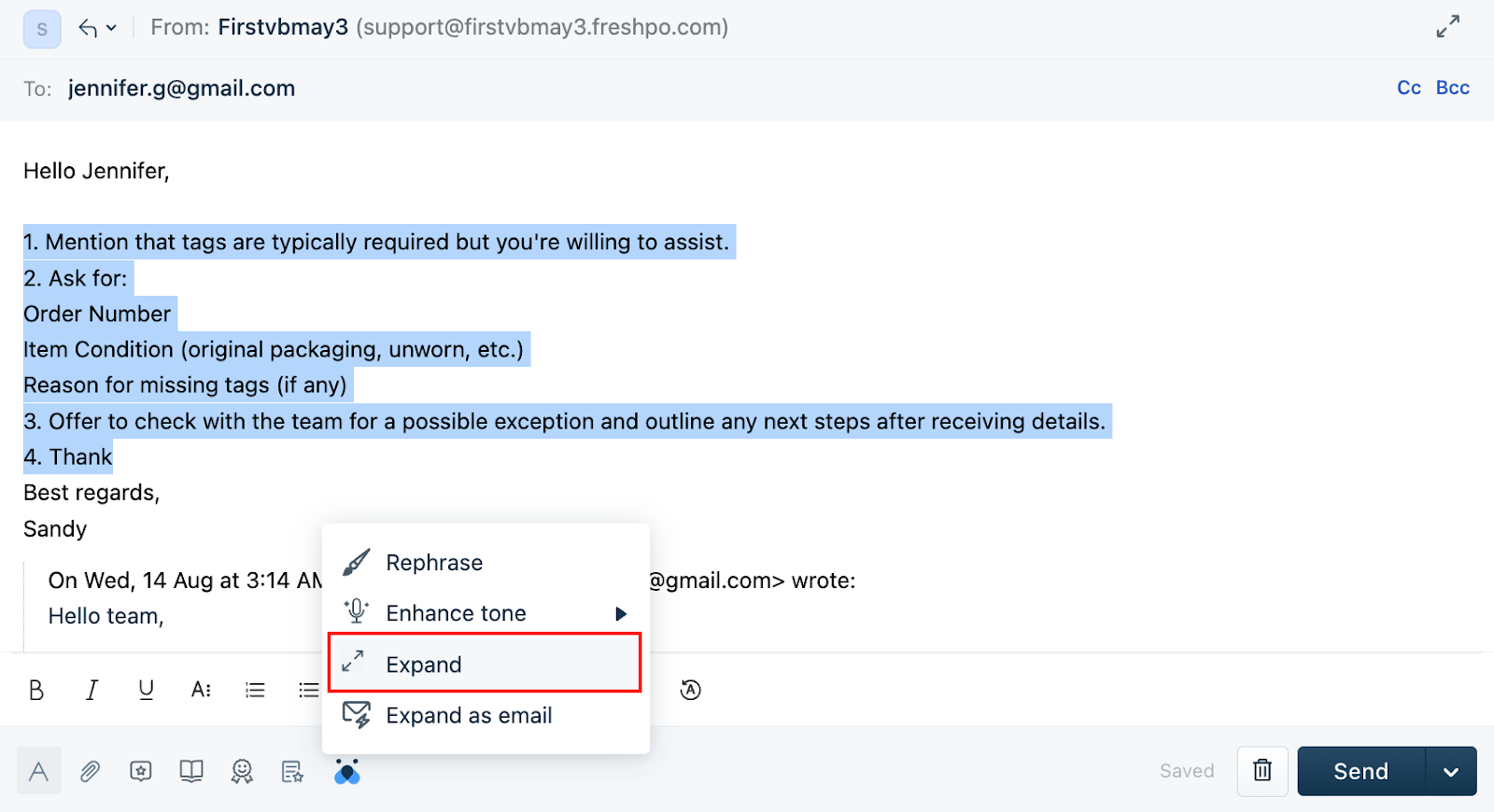
Main features:
- Multi-channel ticketing: Consolidates email, chat, phone, and social support.
- Automation and workflows: Rules and macros automate repetitive tasks.
- Analytics and reporting: Provides insights into performance and customer satisfaction.
AI features:
- Freddy AI: Fetches order details, resolves questions, updates customer profiles, and more using approved data.
Standalone AI tools you can integrate with existing helpdesks
Not ready to move helpdesks? These standalone AI tools plug into your existing helpdesk to add automation, self-service, and conversational support.
Ada
Ada is focused on conversational automation, enabling teams to provide self-service solutions that reduce ticket volume while improving response times.
Its no-code interface makes it accessible for non-technical teams, and its AI capabilities allow for personalized customer interactions at scale.
Best for: Large enterprise businesses looking to reduce support tickets through chat-based support
Potential limitations: Basic features that are free on competitor platforms cost extra on Ada, which limits smaller businesses looking for an all-in-one solution.
Pricing: Starts at $499/month for essential AI features. Higher-tier plans are available on request.
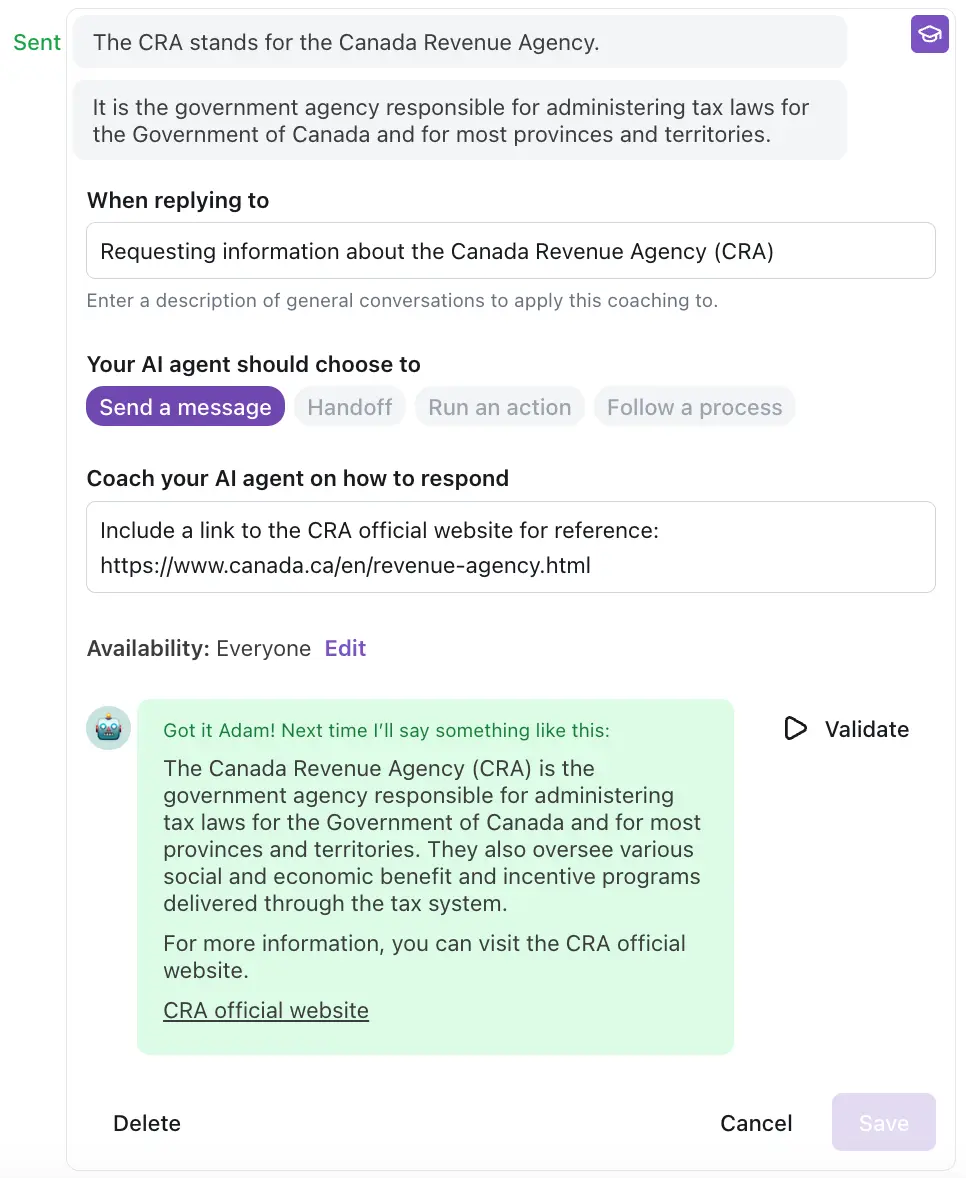
Main features:
- No-code chatbot builder: Quickly design and deploy AI chatbots across web, mobile, and messaging apps.
- Ticket deflection: Automates repetitive queries to reduce human agent workload.
- Multi-language support: Offers conversational support in multiple languages to serve global audiences.
AI features:
- Ada Voice: AI-powered phone support that can respond to customers, take action, and escalate issues in real-time.
- Ada Email: Instant, personalized replies for email threads with the ability to hand off to agents.
Siena
Siena is focused on providing automated support for rapidly growing ecommerce and SaaS brands. With an emphasis on efficiency and self-service, Siena helps teams reduce ticket volume and respond faster, while giving managers visibility into performance metrics.
Best for: Mid-market ecommerce and SaaS companies that want to combine automation with insights
Potential limitations: Lacks clear visibility into AI performance, which can keep support teams in the dark about support performance and customer satisfaction.
Pricing: Starts at $500/month with automated tickets at $0.90 each.

Main features:
- Omnichannel support: Handles email, chat, and social media from a single dashboard.
- Custom workflows: Automates repetitive tasks and ticket routing based on rules and customer data.
- Reporting and analytics: Tracks support KPIs and team performance in real time.
AI features:
- Customer Service Agent: Provides contextual, automated responses for common queries.
- Reviews Agent: Responds to every customer review with personalized feedback.
- Siena Memory: Stores key details from customer interactions and turns them into insights reports.
Yuma
Yuma is focused on conversational automation and self-service solutions. It is designed to reduce agent workload while providing fast, personalized responses, making it appealing to growing ecommerce teams.
Best for: Established ecommerce brands looking to integrate sophisticated conversational AI alongside their current helpdesk
Potential limitations: Limited integrations with broader sales stacks mean brands prioritizing sales will have a hard time creating a smooth workflow.
Pricing: Starts at $350/month for 500 resolutions, with higher-tier plans for more resolutions.

Main features:
- Omnichannel support: Handles chat, email, and social messaging from one platform.
- Self-service portals: Allows customers to resolve common issues independently.
- Workflow automation: AI assists with repetitive tasks and ticket routing.
AI features:
- Support AI: Replies to customers on email, WhatsApp, SMS, and social media using your brand’s voice.
- Social AI: Instant responses to social media comments, DMs, and tags.
- Sales AI: Guides shoppers to the relevant product and tracks bestsellers.
What features to look for in a good AI helpdesk
The best AI helpdesk makes support efficient, personalized, and scalable.
Here’s a quick checklist of what to look for when evaluating an AI helpdesk:
- Smart ticket management
- Self-service workflows
- Multi-channel support
- Sales and upselling capabilities
- User-friendly AI controls
- Performance insights
- AI learning and improvement
|
Feature |
What It Is |
Benefit to CX Team |
|---|---|---|
|
Smart ticket management |
AI that deflects repetitive tickets and routes complex issues to agents via macros, recommendations, and copilots |
Frees up time for higher-value tasks like customer retention and streamlined experiences |
|
Self-service workflows |
Automated execution of order edits, address changes, refunds, and cancellations—whenever customers ask |
Eliminates time spent on repetitive requests while offering 24/7 support |
|
Multi-channel support |
All-in-one platform consolidating email, chat, SMS, social media, and phone interactions |
Eliminates the need to switch between platforms while giving customers a variety of contact options |
|
Sales and upselling capabilities |
AI that analyzes shopper behavior and delivers targeted assistance, product recommendations, and offers |
Maximizes revenue impact for CX teams by directly influencing customer buying decisions |
|
User-friendly AI controls |
Intuitive tools and toggles for adjusting AI behavior through knowledge bases |
Allows teams to test and deploy AI quickly without technical expertise |
|
Performance insights |
Dashboards displaying performance metrics, support KPIs, revenue impact, plus custom reporting |
Maintains support quality while providing scalable insights that grow with your business |
|
AI learning and improvement |
Quality assurance features that improve AI through feedback, corrections, and knowledge updates |
Enables accurate responses that lead to consistent support quality and increased customer satisfaction |
Key takeaways from our review
The future of customer support is AI-driven, and the tools you choose today will define the efficiency, responsiveness, and satisfaction of your support team tomorrow.
If it's still early in your AI helpdesk journey, we have additional resources to help you learn more from the pros before getting started:
Further reading

How to Reduce CX Stress in 2025 with AI and Automation
TL;DR:
- Automate repetitive questions to give agents time back. Use tools like Help Centers, Flows, and AI agents to handle common queries so agents can take care of more complex issues.
- Lower response times with automation. Set up automated email responses, use Flows, and leverage AI Agents to reply to customers faster.
- Maintain a consistent tone of voice with AI. Automate QA processes and provide custom tone instructions to ensure every response aligns with your brand's voice.
- Self-serve returns and use chat campaigns to upsell. Use tools like Loop Returns for self-serve returns and Gorgias Convert to boost revenue with personalized upselling campaigns.
According to Salesforce research, 77% of support staff have dealt with increased and complex workflows compared to the year prior. In addition, 56% of agents have experienced burnout due to support work.
As teams transition into the next era of CX—one where almost every customer expects efficiency, convenience, and friendly and knowledgeable service –– they’ll need the support of more than just a stellar lead to avoid the stress that comes with the job.
AI and automation are valuable and impactful tools that can aid teams in providing these top-notch experiences while helping agents lower their own stress.
Here are seven ways to leverage AI and automation to increase agent productivity, meet customer expectations, and decrease burnout on CX teams.
{{lead-magnet-1}}
How to reduce stress with AI and automation
While there will always be reasons for human intervention, here are seven support challenges that AI and automation can solve for CX teams long term.
- Tackle repetitive questions
- Lower response times
- Keep a consistent tone of voice
- QA responses at scale
- Upsell customer conversations
- Let customers self-serve returns
- Address common points of confusion
1) Tackle repetitive questions
Every CX team receives repetitive questions like “where is my order” (WISMO), “can I change my shipping address,” or “what is your return policy” every single day. These questions add up over time, creating frustration and burnout for agents and longer response times for customers.
Instead, teams can leverage AI and automation to answer these questions and take time back for other essential tasks.
How to use AI and automation to reduce repetitive questions
If you use Gorgias, there are a couple of ways to put automation to work.
- Lowest effort: Create a Help Center. Help Centers are beneficial for a couple of reasons. First, they give customers an avenue for self-service. Second, they're the primary knowledge source that Gorgias AI Agent draws from. To make setup a breeze, browse 50 help center templates with included answers, all customizable to your brand’s policies.
- Medium effort: Set up Flows. Flows guide simple automated interactions that get customers the answers they need. Flows might help customers understand sizing, learn how long delivery will take, or find warranty information.
- Highest effort: Activate AI Agent. AI Agent is conversational AI that can handle repetitive tickets for teams by learning your brand’s policies, tone of voice, and specific instructions.

"Gorgias's AI Agent has been a game-changer for us, allowing us to automate nearly half of our customer service inquiries. This efficiency means we don’t need to hire additional staff to manage routine tasks, which has saved us the equivalent of two full-time positions.
—Noémie Rousseau, Customer Service Manager at Pajar
Resource: How to automate half of your CX tasks
2) Lower response times
Many customers get frustrated due to delayed support responses, especially if (they believe) they’re asking a simple question. Not only can AI and automation support by offering responses to these questions, they allow human agents to respond faster to customers who have more complex questions.
How to use AI and automation to lower response times
- Lowest effort: Use automated acknowledgment responses to reassure customers that you’ve heard them, and provide a time frame for when they can expect to hear back. This can be as simple as setting up an email to trigger each time a customer sends in a support request.
- Medium effort: Set up Flows in Chat to give customers quick, automated answers to common questions.
- Highest effort: Use AI Agent to answer customers 10x faster than your human agents.

AI Agent has been an effective tool for the team at luxe golf accessory shop VESSEL. “Now we’re able to get back to people so much faster than before,” says Lauren Reams, their Customer Experience Manager.
“We can quickly collect information – avoiding the back and forth questions like what is your name, email or shipping address. Using AI to eliminate the back and forth has been great, and getting back to customers much faster than before has been the biggest win for our team.”
3) Keep a consistent tone of voice
If customers see an inconsistent tone of voice across responses, it’ll affect your brand credibility. It also causes confusion and may create issues maintaining repeat and loyal customers.
How to use AI and automation to keep tone of voice consistent
- Lowest effort: Set up AI Agent’s tone of voice with custom instructions. While AI Agent comes with three pre-set options (Friendly, Professional, and Sophisticated), you can also provide custom Guidance for how you’d like it to sound.
- Medium effort: Use Macros or templated responses to always keep agents on brand.
- Highest effort: Conduct agent training via an automated QA system. Auto QA can provide instant feedback on agent responses to ensure they’re on brand and use the right tone of voice.

4) QA responses at scale
Manual quality assurance checks are time-consuming and often inconsistent. But they’re key to providing great support at scale while maintaining a high standard across thousands of interactions. Aside from catching any errors, a regular QA process also builds trust with customers, increases personalization, and helps agents improve over time.
How to use AI and automation for QA
Automated quality assurance can provide up to 90% accuracy, according to research by McKinsey. To ensure 100% of your customer conversations are checked, used Auto QA. This AI-powered QA tool evaluates your team's responses—AI or human—based on Resolution Completeness, Communication, and Language Proficiency.

5) Upsell customer conversations
When CX teams are bogged down with an overwhelming amount of tickets, there’s going to be a lack of time and opportunity to upsell in customer conversations. This is especially true when dealing with angry or upset customers, and during high-impact periods like BFCM.
How to use AI and automation for upselling
Activate onsite marketing campaigns with Gorgias Convert to provide product recommendations and promote current discounts, sales, or campaigns.
For example, you can use AI to promote relevant items to shoppers to increase their cart value. You might highlight items that are frequently bought together, or show a bundle that would make a great gift for someone. Research shows that these types of personalized recommendations can increase average order value (AOV) by 15%.

Resource: 5 Holiday Onsite Campaigns to Maximize Year-End Sales
6) Let customers self-serve returns
The National Retail Federation (NRF) projects that retail returns will total $890 billion in 2024. With so many brands losing money from returns, it’s essential that you find ways to mitigate them.
How to use AI and automation for returns
By switching to Gorgias, Audien Hearing saw nearly a 5% drop in return rates. And Rumpl saw $8,000 in recouped return fees by integrating Loop Returns with Gorgias.
Loop lets customers self-serve returns through a returns portal that encourages exchanges instead. It makes the entire process a breeze, and eliminates back and forth between customers and busy support teams.

7) Address common points of confusion
Many times, issues that were completely avoidable are escalated, leaving support teams with more tickets and already frustrated customers. These issues are likely common points of confusion that you can easily solve before they ever reach your customers.
How to use AI and automation to ease confusion
If you use Gorgias, here’s how you can leverage automation:
- Lowest effort: Update your Help Center to address FAQs or policies customers have found confusing in the past.
- Medium effort: Create Flows to address frequently asked questions.
- Highest effort: Set up AI Agent’s handover rules to only escalate certain topics to your human team.

“I’ve been in this role for four years and this was probably our best back to school season yet. In past years, you knew you were going to come in and be bogged down – but this year was way more seamless and much less stressful and that’s thanks to AI Agent.”
—Danae Kaminski, Customer Care Team Lead at Jonas Paul Eyewear
Get time back to do what really matters
At Gorgias, our goal is to create solutions to the real problems CX professionals face every day. Tools like AI Agent make it possible for teams to provide better customer experiences, reduce agent stress, and create more cohesive and positive working environments overall.
”Thanks to the time we've saved by automating many of our routine tasks, our team has had the chance to bond more,” says Noémie.
“We even had time for a team picnic and painted a picnic table outside! It’s been great to step away and spend time as a team occasionally, knowing that our customers are still being taken care of by the AI Agent. It’s really improved team morale.”
{{lead-magnet-2}}

How to Refresh Your Help Center for 2025: A Step-by-Step Guide
TL;DR:
- Audit your help center. Review analytics, gather feedback, and test usability to identify gaps and outdated content.
- Update and optimize content. Add trending FAQs, visuals, and clear formatting to improve readability and usability.
- Boost accessibility and SEO. Place links across your site, optimize with keywords, and integrate with proactive support tools.
- Leverage AI for better support. Use your help center to train AI tools and regularly update content for accuracy.
The start of a new year is the perfect time to give your help center the refresh it deserves. For many ecommerce brands, the help center is one of the most underused support tools—yet it's also one of the most powerful. 88% of customers already search your website for some kind of knowledge base or FAQ.
Customers expect fast answers, and a well-designed, updated help center can meet their needs while taking some weight off your support team. We’ll walk you through why refreshing matters and how to do it.
{{lead-magnet-1}}
Why refresh your help center?
90% of consumers worldwide consider issue resolution their top priority for customer service. A robust help center gives you the tools to meet this expectation, delivering fast and reliable solutions that simplify your customers’ lives.
A well-designed help center benefits both your customers and your team. For customers, it lets them solve problems quickly and independently. Instead of waiting for an email response or queuing for live chat, a help center empowers them to find answers on their own terms 24/7.
For your team, a refreshed help center is transformative, too. Here’s what a help center update can achieve:
- Deflect repetitive pre-sale questions: Save your agents from answering the same FAQs over and over by addressing common queries proactively in your help center.
- Support your team: Equip agents with easy access to up-to-date product, service, and policy information. You’ll reduce response times, and your team will deliver consistent answers.
- Train AI tools: Turn your help center into a powerful data source for AI tools. Comprehensive, structured content helps AI provide accurate and consistent responses, giving customers fast solutions and further reducing ticket volume.
In short, refreshing your help center will improve customer experience and boost efficiency across your entire customer service strategy. It’s a win-win for everyone.
How to refresh your help center: 4 steps to follow
Refreshing your help center doesn’t have to be overwhelming. By breaking the process into clear, actionable steps, you can transform your help center into a powerful self-service tool that delights customers and supports your team.
Here are four key steps to guide your refresh.
Step 1: Audit your existing help center
Before making any major changes, you need to understand where your help center currently stands. A thorough audit will help you identify areas for improvement and ensure you make targeted updates.
Here's how to start:
Review analytics
Dive into your help center metrics to spot underperforming content. Look at article views, time-on-page, and bounce rates. Low engagement might mean the content is unclear, irrelevant, or hard to find.
With a customer experience platform like Gorgias, you can view the performance of each article:

Survey your customers
Customer feedback is invaluable. Use surveys or follow-up emails to ask customers what information they had trouble finding. Their responses can highlight blind spots in your help center.
Add CSAT questions
At the end of each help center article, include a simple question like, "Was this content helpful?" Use the feedback to pinpoint which articles are effective and which may need improvement.

Test usability
Put yourself in your customers’ shoes. Try searching for answers to common questions. Is the layout intuitive? Are the search results helpful? A smooth user experience is key to a successful help center.
Evaluate content freshness
Check if your articles are outdated or missing important updates, like new product features or policy changes.
Read more: How to create and optimize a customer knowledge base
Step 2: Update and optimize your help center content
Fresh, well-organized content is the backbone of a great help center. Customers rely on clear and accurate information, so investing in your content can transform your help center into a powerful self-service tool.
Here’s how to refresh your content and make it shine:
Add trending FAQs
Regularly analyze support tickets to identify common and emerging questions. Integrate these into your knowledge base to address customer needs proactively and reduce incoming tickets.
Create multimedia content
Text alone isn’t always enough. Use images, GIFs, and videos to break down complex topics and make instructions easier to follow. For example, a quick explainer video can save customers time and eliminate confusion.
Princess Polly’s customer help center exemplifies what a great help center should look like. Its visually appealing design ensures that customers can quickly navigate to the information they need. Whether they’re looking for help with shipping, payments, returns, or any other issue, the intuitive layout makes the process simple and stress-free.

Gorgias lets you customize fonts, logos, and headers for your Help Center without any coding. If you want more customization, you can dip into HTML and CSS to tailor specific elements.
Standardize your tone
Ensure your content reflects your brand voice while staying approachable and customer-friendly. Consistency builds trust and reinforces your brand identity.
Need help finding your brand voice? Read AI Tone of Voice: Tips for On-Brand Customer Communication for guidance.
Update outdated articles
Review older content for inaccuracies or missing information, such as policy changes or new product details.
Structure for readability
Use bullet points, short paragraphs, and clear headings to make articles easy to scan. Most customers skim for quick answers—design your content to match their behavior.
Step 3: Make your help center easy to find
Even the most well-crafted help center is ineffective if customers can’t locate it. Ensuring visibility across all customer touchpoints is key to driving engagement and making self-service the first stop for support. Here’s how to do it:
Link it everywhere
Make your help center easily accessible by placing links in strategic locations, such as your website’s header, footer, and main navigation menu. Include links in transactional emails, like order confirmations, tracking updates, or shipping updates, where customers often have questions.
Improve SEO
Optimize your help center articles with keywords your customers are likely to search for. Use clear, concise titles, meta descriptions, and headings to boost search engine visibility and help customers find answers directly from Google.
Integrate with support tools
Use tools like automated chat and automated email responses to proactively surface relevant help center articles. For instance, when customers type a question in a chatbox, suggest related articles before escalating to a support agent.
Read more: Offer more self-serve options with Flows: 10 use cases & best practices
Promote it proactively
Don’t wait for customers to stumble upon your help center—promote it! Highlight it in onboarding emails, social media posts, and banners on your site.

Jonas Paul Eyewear ensures their help center is easy to access by prominently linking it in the website’s footer under the “Quick Links” section. The thoughtful placement ensures customers can quickly navigate to the help center from any page, making it a convenient resource for addressing their questions or concerns.
Read more: Boost your Help Center's visibility: Proven strategies to increase article views
Step 4: Use your help center to power AI tools
Your help center isn’t just for customers—it will also level up your AI-driven support strategy. By structuring your knowledge base effectively, you enable AI tools to deliver accurate, reliable, and consistent answers to customer queries.
Here’s how to make it work:
Create comprehensive content
Ensure your help center articles cover a wide range of customer questions in detail. This makes it easier for AI tools to pull relevant information and respond accurately.
Structure for machine readability
Organize your content with clear headings, bullet points, and simple language. Well-structured articles are easier for AI to parse and interpret.
Focus on consistency
Use uniform terminology across articles to prevent confusion and ensure AI tools can quickly identify relevant data.
Update regularly
Keep your knowledge base fresh by adding new FAQs, updating outdated content, and incorporating customer feedback. Up-to-date information ensures AI tools provide answers that align with your latest products, policies, and services.
Test AI performance
Periodically review how well your AI tools are using your help center content to address customer needs. Identify gaps in information and fine-tune articles as needed.
Dr. Bronner’s built their help center to power AI Agent, a conversational support assistant that answers both transactional and personalized customer inquiries in the same style as a human agent. Making this change helps the brand save $100,000 a year and decrease their resolution time by 74%.

💡Pro Tip: Transform your help center into an AI training powerhouse with Gorgias’s help center AI optimization guide. This guide offers actionable tips for making your knowledge base AI-ready.

By using your help center to power AI tools, you’ll improve customer self-service options and lighten the load on your support team. AI-enhanced support delivers faster resolutions, higher customer satisfaction, and a scalable approach to customer service.
Elevate your support strategy with a help center refresh
Refreshing your help center isn’t just about improving customer experience—it’s a game-changer for your entire support strategy. With tools like Gorgias’s Help Center, you can empower customers to self-serve while equipping your team with the resources they need to excel.
In 2025, make your help center the cornerstone of your support operations—and watch the results speak for themselves.
{{lead-magnet-2}}

AI Quality Assurance: The New Standard for Customer Support QA
TL;DR:
- The landscape of QA is moving from manual to AI-powered, where AI can analyze every customer interaction, uncover patterns, and suggest data-driven changes at scale.
- Automating QA allows ticket reviews to be routine. This means customers will always receive high-quality support.
- Every customer interaction is reviewed with AI QA—not just a sample. This gives support leaders full visibility into performance and service quality.
- AI QA saves time and improves agent and Gorgias AI Agent feedback. By automating ticket reviews, agents receive instant, unbiased feedback, and leaders can focus on big-picture CX improvements.
This year, 71% of customer experience (CX) leaders are using AI and automation to handle the holiday shopping season. These tools, including AI agents and email autoresponders, speed up tasks like responding to customers and updating orders.
But answering tickets isn't enough. Responses must also be high-quality, whether from humans or AI. And while customer satisfaction (CSAT) is the standard measure of how successful these interactions are, they have major limits.
CSAT scores don’t tell the full story about whether agents were helpful or if they used on-brand language. These gray areas in quality lead to missed sales, higher return rates, and frustrated customers during peak periods.
AI quality assurance (QA) is changing that. In this article, we’ll see what QA looks like today, how AI can simplify the process, and how CX teams can use tools like Auto QA to improve quality across all conversations.
{{lead-magnet-1}}
Traditional customer support QA is falling by the wayside
Today, QA in customer support is a largely manual responsibility. Customer conversations are reviewed by CX team leads to ensure customer satisfaction and identify areas for agent coaching. Team leads evaluate agent responses against a checklist of best practices, including the proper use of language, product knowledge, consistency, and helpfulness.
However, reviewing tickets takes a long time.
QA is important, but it's hard to prioritize when customers are actively waiting for help with refunds, urgent order edits, or negative reviews. And when CX teams are under-resourced and short-staffed, it’s easy to put QA on the back burner.
What’s more, as AI plays a bigger role in responding to customers, quality assurance must evolve to ensure the quality of AI-generated responses, not just human responses.
Over time, the lack of QA in CX can hold back support teams for three reasons:
- Delayed feedback makes it harder for agents and AI tools to improve.
- Leaders have less time to train agents and refine workflows.
- Inconsistent service risks losing customer trust and loyalty.
What is AI-powered QA in CX?
AI-powered quality assurance (QA) uses AI to automate the process of reviewing customer interactions for resolution completeness, communication, language proficiency, and more.
Instead of team leads spending hours manually sifting through tickets, AI takes over and evaluates how well tickets were resolved by agents.
Shifting this traditionally manual work to an automated process pulls teams out of the weeds and into more beneficial work like speaking to customers and upselling.

With AI QA, routine ticket reviews are not just an optional part of your customer service strategy, they become a permanent part of it. The road to greater customer trust, resolution times, and stronger product knowledge becomes easier.
Read more: Why your strategy needs customer service quality assurance
Why choose AI-powered QA over manual QA?
Manual QA is like trying to review a handful of tickets during an incoming flood of new customer requests. Team leads can only focus on a small sample, leaving most interactions unchecked. Without complete visibility, creating a standard across all interactions is challenging.
Now, switch over to AI QA. You don’t have to choose between QA duty or answering tickets—QA checks are automatically done. You’ll still need to monitor AI’s performance, but now there’s more time to focus on creating strategies that improve the customer experience.
Here’s how AI QA and manual QA measure up to each other:
|
Feature |
AI QA |
Manual QA |
|---|---|---|
|
Number of Tickets Reviewed |
All tickets are reviewed automatically. |
Only a small sample of tickets can be reviewed. |
|
Speed of Reviews |
Reviews are completed instantly after responses. |
Reviews are time-consuming and delayed. |
|
Consistency |
Feedback is consistent and unbiased across all tickets. |
Feedback varies depending on the reviewer. |
|
Scalability |
Scales, regardless of ticket volume. |
Struggles to keep up with high ticket volumes. |
|
Agent Feedback |
Provides instant, actionable feedback for every resolved ticket. |
Feedback is delayed and limited to a few cases. |
|
Leader Advantage |
Frees up leaders to train the team and improve workflows. |
Disadvantageous, as leaders spend most time manually reviewing tickets. |
7 benefits of using AI quality assurance in CX
AI quality assurance helps CX leaders move beyond manual reviews by offering fast, thorough insights into performance and customer needs. Here are seven key benefits it brings to your team.
1. Improved visibility into customer interactions
AI QA reviews every ticket, giving CX leaders a complete view of agent performance and customer trends. Nothing slips through the cracks, so you can act on real data each and every single time.
What the team wins: Key areas to focus on to improve the customer experience.
What the customer wins: A consistent support experience where their concerns are fully addressed.
2. Instantly identify major customer pain points
Only a third of customers highly trust businesses, and without QA checks in place, that trust only deteriorates.
AI QA feedback can highlight confusing policies or common product issues that lead to unhappy customers. With instant feedback, teams can quickly make changes and create better, consistent customer experiences.
What the team wins: Faster fixes for recurring issues.
What the customer wins: A smoother, frustration-free experience.
3. Faster identification of process gaps
Agents can receive feedback that instantly highlights gaps in workflows or unclear escalation steps. This is an efficient way to resolve issues within the wider team before they become more significant problems.
What the team wins: Process issues are solved quickly.
What the customer wins: Faster resolutions with little to no delays.
4. Standardized scoring for AI and human agents
AI QA evaluates both Gorgias AI Agent and human agent interactions using the same criteria. This creates a level playing field and ensures all customer interactions meet the same quality standards.
What the team wins: Fair evaluations for both AI and human responses.
What the customer wins: High-quality support, no matter who handles the ticket.
5. More time for coaching and training
With less time spent on manual reviews, leaders can dedicate more energy to team development. Training sessions guided by AI insights help agents improve quickly and ensure the team delivers support that aligns with protocols.
What the team wins: More focused skill-building based on data.
What the customer wins: Clearer and more accurate support.
6. Drives continuous knowledge for the entire team
AI QA is helpful for showing agents which areas they need more training on, whether it's being better about using brand voice or polishing up on product knowledge. This leads to better support processes and stronger product understanding across the team.
What the team wins: Better support tactics and product expertise.
What the customer wins: Faster resolutions due to knowledgeable agents.
7. Enhanced customer experience through consistently high-quality support
Since all tickets are reviewed, teams can feel confident they’re delivering high-quality support on a regular basis. Customers get clear, helpful answers, while agents gain insights from every ticket with AI feedback.
What the team wins: Consistent support performance.
What the customer wins: Reliable support they can trust.
How accurate is AI QA?
AI QA analyzes tickets using predefined categories to evaluate how complete and helpful agent responses are. Let’s take a closer look at how it maintains accurate ticket reviews with an AI QA tool like Gorgias’s Auto QA.
It measures multiple metrics
Auto QA evaluates tickets based on three key areas: Resolution Completeness, Communication, and Language Proficiency.
For Resolution Completeness, it checks if all customer concerns were fully addressed. For example, if an agent resolves only one of two issues raised, the ticket is marked incomplete. Tickets where customers resolve issues on their own or don’t respond to follow-ups can still be graded as complete if handled appropriately.
Communication quality is scored on a scale of 1 to 5, assessing clarity, professionalism, and tone. Agents earn higher scores when they provide clear solutions and remain positive throughout the interaction.
Finally, Language Proficiency evaluates whether an agent displayed high proficiency in the language of the conversation. The score considers how well spelling, grammar, and syntax were employed.

Teams can improve AI with their own feedback
Auto QA isn’t set in stone. Team leads can expand on AI-generated feedback by adding their comments. For example, if a resolution is graded as ‘Incomplete,’ a team lead can explain why and provide additional context. This helps clarify the evaluation for the agent and also helps the AI model improve over time.
How to get started with AI quality assurance using Auto QA
Ready to bring the benefits of AI QA to your team? Here’s how to get started with Auto QA:
- Audit your current QA process to identify gaps. How do you currently review tickets? Pinpoint areas where manual QA falls short, such as inconsistent feedback or missed interactions.
- Pilot Auto QA with a small team. Introduce Auto QA to a small group of agents to test its impact. This allows you to find out how the new QA process fits into your workflow and how it affects agent performance.
- Use AI insights to refine processes. Analyze the feedback Auto QA provides to identify process gaps or recurring issues. Use these insights to update your workflow, improve training, and address root causes of customer pain points.
- Gradually scale adoption across the team. Once the pilot is successful, roll out Auto QA to more agents. Make sure everyone is trained on how to use its insights and integrate the tool into daily operations.
- Monitor and provide feedback to improve AI accuracy. Review Auto QA’s evaluations to ensure accuracy. Add manual feedback as needed to fine-tune its scoring on future tickets.
- Measure the impact on performance and satisfaction. Track key metrics like ticket close rates, resolution times, and customer satisfaction scores. Use this data to understand how Auto QA transforms your QA process and drives better results.
Make high-quality responses a standard with Auto QA
AI QA isn’t just about automating ticket reviews — it empowers CX leaders to focus on what truly matters: training and improving processes.
Leave spot-checking and inconsistent application of policies and brand voice in the past. As a built-in feature of Gorgias Automate, Auto QA makes high-quality customer interactions your brand’s standard.
Book a demo now.
{{lead-magnet-2}}

What to Do After Black Friday: A Guide to Post-BFCM Planning
TL;DR:
- Reflect quickly: Analyze customer service metrics like CSAT, FRT, and ticket volume immediately after BFCM to identify what worked and what didn’t.
- Optimize self-service: Update FAQs and help centers to address gaps revealed in BFCM support inquiries.
- Streamline operations: Audit staffing, inventory, and fulfillment to avoid bottlenecks in future peak seasons.
- Turn insights into action: Use BFCM data to set measurable goals and implement quick wins for success next year.
Nailing customer support during BFCM is all about staying ahead of the game and making smart moves—fast.
But the real key to success lies in what you do when the rush is over. Treating BFCM as a learning opportunity allows you to refine your customer experience (CX) and set yourself up for an even better performance next year.
Without a plan for what to do after Black Friday, it’s easy to repeat mistakes or overlook key trends that could make all the difference next year.
In this article, we’ll share a simple framework to help you evaluate your BFCM performance and turn insights into actionable steps for long-term CX improvement.
{{lead-magnet-1}}
Key areas to review post-BFCM
It’s best to reflect on key areas like customer service, tech performance, customer behavior, and operations right after BFCM versus waiting until late next year.
By taking a closer look now, you can spot what worked, fix what didn’t, and start applying those insights to other big sales events throughout the year—not just BFCM.
A little effort now = a lot of payoff later!
1. Customer service metrics: Where did your team shine (or struggle)?
By analyzing key metrics, you can identify what worked, where your team excelled, and what areas need improvement to better prepare for future busy seasons. Key metrics include:
- Customer Satisfaction (CSAT): Gauge how happy customers were with their interactions. Look for trends in both positive and negative feedback to pinpoint what delighted or frustrated customers.
- First Response Time (FRT): Assess if your team met expectations for quick responses during peak periods.
- Average Resolution Time (ART): Evaluate how efficiently issues were resolved and whether there were any bottlenecks.
- Contact Rate: Examine whether there was a surge in inquiries, and uncover why.
- Net Promoter Score (NPS): Determine how likely customers are to recommend your brand post-BFCM.
- Ticket Volume: Review peak times and common customer issues. This insight can help forecast future support needs and ensure your team is adequately prepared for high-demand events.
Tools like Gorgias’s Ticket Insights can reveal which issues—like discounts, shipping policies, or damaged orders—dominated your support tickets.

For a more comprehensive view, Gorgias’s Support Performance dashboard shows how customer service influenced sales, including tickets converted, conversion ratios, and total revenue. These insights are invaluable for understanding the connection between support efficiency and revenue growth.

Brands like Obvi, a leading supplement company, have leveraged Gorgias to enhance their support strategies.
Obvi serves a large number of shoppers seeking pre-sales guidance to choose the right supplements. By using Gorgias’s Flows and Article Recommendations, they provide instant, automated answers to frequently asked questions directly within Chat.
Here’s how it works:
- Flows offer shoppers a menu of common queries about products and shipping, providing fast answers to top concerns.
- For more specific questions, Article Recommendations scan Obvi’s Help Center articles and share the most relevant answer. For example:some text
- How do I mix Obvi collagen?
- Is Obvi vegan?
- Can I take collagen while pregnant?

To fine-tune their approach, Obvi uses data from their tickets to identify recurring customer questions. By analyzing the gaps between their initial FAQs and real customer inquiries, they adjusted their automated responses to better meet customer needs.

“We thought we knew what our FAQs were, but data from Gorgias was incredibly insightful to understand which FAQs to automate. That's one reason it's really valuable to have our Helpdesk tickets and automation features in one tool.”
—Ron Shah, CEO and Co-founder at Obvi
2. Technical performance: Did your tools hold up under pressure?
While marketing efforts often steal the spotlight, savvy brands know that backend systems are the unsung heroes of Black Friday and Cyber Monday.
Start by auditing critical areas such as platform downtime, checkout errors, or slow response times. These issues not only frustrate shoppers but can also lead to lost revenue and customer loyalty during your busiest shopping days of the year.
Next, evaluate how well your tools were able to manage peak volumes. Did your helpdesk, CRM, and ecommerce platforms work seamlessly together, or were there gaps in your integrations?
If switching between platforms slowed your team down or caused data silos, consider streamlining your tech stack with an all-in-one CX solution.
For example, conversational AI platforms like Gorgias enable CX teams to consolidate support, sales, and automation into a single tool. Gorgias combines Helpdesk and AI Agent to resolve customer issues efficiently, while Convert supports upselling and increasing customer lifetime value.
A streamlined, integrated platform not only boosts efficiency but also helps your CX team focus on what matters most: delivering exceptional customer experiences.
3. Customer trends and behavior: What did your shoppers really want?
Start by reviewing product demand, buying patterns, and cart-building behaviors. Were there any unexpected customer needs or shifts in preferences? Identifying these trends can help you refine your inventory planning, marketing strategies, and product offerings.
For example, here’s a detailed breakdown of what to look for:
Product demand shifts
Use these insights to adjust inventory planning for future campaigns. Ensure you have sufficient stock of trending products and create promotional bundles for underperforming items.
- Which products outperformed expectations? Were they planned bestsellers or surprise hits?
- Did slow-moving products unexpectedly gain traction, or did top-sellers underperform?
Cart-building behaviors
Tailor future cart-building promotions to encourage higher Average Order Value (AOV). For instance, highlight complementary products or offer discounts on bundles.
- Did customers prefer individual purchases, or did bundling promotions drive higher AOV?
- Were there abandoned cart trends tied to specific products or price thresholds?
Unexpected customer needs
Incorporate these suggestions into your product development or cross-sell strategies. Highlight related products in future campaigns to meet these emerging needs.
- Did reviews or support tickets indicate demand for features, colors, or sizes you didn’t offer?
- Were there inquiries about add-on products or product pairing ideas?
Self-serve helpfulness
If you have an FAQ page or Help Center, evaluate how well it performed. Did customers find the information they needed, or did they still open tickets for common questions?
Metrics like Article Views, Number of Searches, and Click-Through Rates can show how effectively your self-service resources meet customer needs.
If customers contact support for information already in your Help Center, it may indicate unclear articles or poor visibility of resources. This means you should rewrite unclear articles, optimize search terms, and ensure Help Center links are prominently displayed across your website and emails.
4. Operational challenges: Where did the stress show up most?
BFCM is a stress test for your operations, and reflecting on how well your systems handled the surge can help you uncover critical areas for improvement.
Staffing
Start by reviewing your staffing during peak periods. Did your customer service and warehouse teams feel overwhelmed, or were they adequately supported?
Questions to Ask:
- Were there enough team members to handle the workload?
- Did customer service or warehouse teams experience burnout or delays?
Next Steps:
- Plan staffing schedules around peak demand forecasts.
- Cross-train employees to cover high-pressure roles, such as fulfillment or customer support.
- Offer incentives, like performance bonuses, to encourage seasonal staff retention.
Preparing your team with a more flexible schedule and extra resources for high-demand areas can make all the difference.
Order fulfillment
If order fulfillment workflows slowed down or became error-prone, it may be time to optimize your processes.
Questions to Ask:
- Were there delays in shipping or errors in packaging?
- Did order accuracy or speed decline as volumes increased?
Next Steps:
- Audit fulfillment workflows to identify slow or repetitive steps.
- Invest in automation for picking, packing, and shipping processes.
- Partner with a third-party logistics (3PL) provider if in-house capacity was overwhelmed.
Inventory management
Stockouts or overstock situations during BFCM can directly impact both sales and customer satisfaction.
Questions to Ask:
- Did stockouts or overstock situations impact your Black Friday sales?
- Was inventory tracking accurate during the busiest days?
Next Steps:
- Implement real-time inventory tracking to reduce discrepancies.
- Use demand planning software to improve forecasting for top-selling products.
- Bundle slow-moving inventory with bestsellers in future holiday deals to avoid overstock.
Operational challenges often have a ripple effect on customer experience. By reflecting on these areas—staffing, fulfillment, and inventory—you can identify actionable improvements that streamline operations and create a smoother experience for both your team and your customers.
Building a CX improvement plan post-BFCM
Once you've reviewed the key areas of your BFCM performance, the next step is turning those insights into actionable strategies. Here’s how to build a CX improvement plan that sets you up for long-term success.
Step 1: Document lessons learned before they’re forgotten
Start by centralizing everything you’ve uncovered from your retro.
Use collaborative tools like Notion, Google Docs, or Trello to organize insights across customer service, tech performance, and operations.
And don’t just focus on observations—highlight actionable takeaways. For example, instead of noting “high contact rates,” document the underlying causes, like gaps in FAQs or unclear return policies.
If you’re feeling overwhelmed by the volume of data, let AI do the heavy lifting. Use prompts like these to quickly spot patterns:
- “Analyze the common themes in this ticket data and summarize the top three trends.”
- “Identify recurring customer complaints and suggest improvements to address them.”
- “Provide recommendations to optimize self-service options based on this dataset.”
AI tools can save you time and ensure nothing slips through the cracks as you plan your next steps.
Step 2: Tackle your biggest support pain points
Analyzing challenges in your CX processes can reveal quick wins and long-term improvements. Here are a few common support pain points and how to address them:
High contact rates
A surge in customer inquiries often signals that self-service options aren’t meeting expectations.
Solution: Add or update tools like chat widgets, Help Centers, and post-purchase emails to proactively answer common questions.
Inconsistent response times
This usually points to workflow inefficiencies or a lack of team bandwidth.
Solution: Use automation to prioritize urgent tickets, deflect repetitive inquiries, and ensure smoother workflows.
Low CSAT scores
Frustration with slow resolutions or insufficient empathy often leads to poor satisfaction ratings.
Solution: Invest in empathy training and implement faster resolution strategies, like automating FAQs or integrating sentiment detection tools to flag unhappy customers.
AI escalation issues
While tools like Gorgias’s AI Agent can streamline support, improper setup can lead to automation loops that frustrate customers.
Solution: Define rules for when AI should escalate to a human, feed it more comprehensive data (like updated Help Center articles), and set boundaries for topics it shouldn’t handle.

For example, even with the efficiency provided by their Helpdesk, Obvi found Black Friday and Cyber Monday to be a hectic and stressful period for their small customer support team—just one full-time agent and half of another team member’s time.
The influx of customer inquiries made it difficult to focus on more complex tickets that could save sales from unhappy customers or convert inquiries into purchases. Instead, their team was bogged down by thousands of repetitive questions, like “Where is my order?”
Automating answers to repetitive questions gave the Obvi team the room to focus on personalized and revenue-driving customer interactions, like engaging with their community of 75,000 women.
“Instantly, our CX team had time to prioritize important matters, like being active in our community of 75,000 women instead of sitting answering emails.”
—Ron Shah, CEO and Co-founder at Obvi
The extra bandwidth helped Obvi drive over 3x the purchases from support conversations compared to previous years. AI Agent also enabled their team to reach inbox zero by 6 pm—during Black Friday week!
By automating 27% of their inquiries, they not only improved their response times but also handled over 150 tickets daily with just 1.5 agents, driving 10x more sales during BFCM.
Step 3: Focus on quick wins that deliver big impact
Even the smallest changes can deliver a big impact.
For example, update FAQs based on ticket trends or refine chat flows to reduce repetitive questions. Consolidating your CX tools into an omnichannel helpdesk like Gorgias can also reduce agent workload while delivering consistent customer experiences.
Repetitive inquiries—like shipping updates, return questions, or product FAQs—don’t need to consume your team’s time. Automating these workflows can significantly lighten your team’s load while keeping response times quick.
Gorgias users, for example, can automate up to 60% of support tickets with conversational AI tools like AI Agent, enabling teams to focus on higher-value interactions.
Quick wins aren’t just about streamlining support—they can also drive measurable results.
For instance, Pajar, a footwear brand, leverages AI Agent to handle common inquiries in English and French. While this is a feature they use year-round, it’s handy during holiday shopping seasons when support teams are under pressure to respond quickly.

This freed up their small team of five agents to focus on complex tickets, achieving impressive results:
- Resolved 45% of queries with automation, surpassing their 30% goal.
- Reduced first response times to just 12 minutes.
- Maintained high satisfaction scores by delivering timely, accurate responses.
With tools like AI Agent and Sentiment Detection, you can automate prioritization for tickets—such as flagging urgent issues or unhappy customers—while still maintaining a personal touch.
Step 4: Level up training and leverage your team’s tools
Peak season often highlights gaps in both team training and CX tools. Addressing these areas not only improves your team’s ability to handle high-pressure situations but also fosters a stronger customer-first mindset across your organization.
Start by leveraging the feedback you’ve collected. Your team has so much data they can review between channels like email, SMS, chat, and social media—both compliments and complaints. You need to be willing to listen to every customer’s needs.
At Love Wellness, customer feedback is treated as a daily priority.
The team has a dedicated Slack channel for feedback, where team members regularly drop insights from all touchpoints. This collaborative approach helps them get familiar with recurring themes, dissect customer needs, and work together on solutions.

The Love Wellness team recommends scheduling recurring feedback share sessions with Product or Website teams—or even inviting those teams into Gorgias to create dedicated views for feedback categories like product improvements or website issues.
Beyond tools and processes, training is crucial. Their team also emphasizes the importance of fostering a customer-first mindset at all levels:
Customer service is one of the main ways they build trust with customers, especially in the personal care and women’s health niche. That’s why the Love Wellness team created an immersive customer experience training program that involves everyone—from the company's president to its office manager.
This holistic approach ensures that every team member, regardless of their role, understands the company’s purpose and how their actions contribute to a seamless customer experience.
Step 5: Prove the ROI of CX to get more resources
Your customer support team isn’t just there to clear tickets—it’s a key driver of revenue, retention, and customer lifetime value (CLV). Yet, too many teams measure success based solely on metrics like response and resolution times. While these are important, they’re only part of the story.
As Zoe Kahn, Manager of Customer Experience and Retention at Chomps, explains:
“Aiming for overly broad goals of ‘surprising and delighting’ customers without a real understanding of how support impacts the whole customer journey or business ROI is a common pitfall. Customer experience, largely driven by the support team, touches every stage of the journey—from pre-sales to post-sales—and directly influences more sales and loyalty.”
To demonstrate CX’s value, it’s crucial to track metrics that reflect your team’s true impact on the business. For example:
- Customer Retention Rate (CRR): How well does your team retain customers over time?
- CSAT Scores: Are your customers satisfied enough to return or recommend your brand?
- Revenue From Support Conversations: How many sales are driven by proactive or reactive support interactions?
By focusing on these KPIs, you’ll incentivize your support team to go beyond answering questions and actively contribute to business goals. This could include suggesting products during conversations, encouraging happy customers to leave reviews, or proactively addressing issues that lead to churn.

Teams using Gorgias have even greater opportunities to prove ROI through tools like the Revenue Statistics dashboard, which tracks metrics like tickets converted into sales, conversion rates, and total revenue driven by support interactions.
“Without knowing how much money your customer experience (CX) drives, you’ll never fully understand your impact on the business or have the data needed to advocate for more resources from leadership.”
—Zoe Kahn, Chomps
Set smarter goals next year
The best way to close out your post-BFCM retro is by setting clear, measurable goals for next year. Use this year’s insights to create actionable targets that enhance your customer support and CX strategy:
- Reduce ticket volume: Implement or improve self-service options like FAQs, chatbots, and Help Centers.
- Decrease response and resolution times: Optimize workflows, invest in automation, or plan for better staffing during peak periods.
- Boost CSAT: Address recurring customer pain points, streamline support processes, and train your team to deliver more empathetic, effective service.
Tools like Gorgias make it easier to turn these goals into reality. With powerful automation, integrated insights, and scalable support solutions, you can transform this year’s lessons into meaningful, lasting improvements.
Start planning now to make next year’s BFCM your smoothest—and most successful—yet!
{{lead-magnet-2}}

How We Keep Talent Density High and Impact Higher at Gorgias
TL;DR:
- High talent density means a team where every member is highly skilled and performs at their peak. This creates a positive ripple effect, where talented individuals enhance each other's effectiveness and drive overall success.
- Gorgias maintains high talent density by following three pillars: hire great talent, part ways with non-performers, and nurture your talent pool.
- Train managers to share 100% honest feedback with direct reports. Honest feedback, performance improvement plans, and fair severance ensure a respectful and constructive approach to managing team dynamics.
- Measure talent density with key metrics. These include performance scores over time, cross-evaluation reviews, regrettable attrition rates, and transparent promotions to ensure fairness and improvement.
At Gorgias, we’ve embraced the concept of high talent density, introduced by Netflix co-founder and CEO Reed Hastings in No Rules Rules, as a foundation of how we operate. The idea is simple: a team is at its best when every member is highly skilled and performing at their peak.
I’ll walk you through exactly how we’ve built a workplace that prioritizes talent density by breaking down what the concept means, how it shapes our hiring process, and how we keep Gorgias a rewarding environment to grow in.
What is high talent density?
High talent density refers to having a team where each member is highly skilled and performs at their best. When a group consists of top performers, their collective effectiveness increases. Hastings notes, "Talented people make one another more effective."
For example, in a team of five exceptional employees, each individual's high performance elevates the group's overall success. If there is even one underperformer, a team's effectiveness decreases by 30 to 40 percent.
The three pillars of high talent density
We follow three pillars to maintain and grow high talent density. These pillars guide how we build and sustain a team of exceptional performers at Gorgias.
- Hire Great Talent: We look for people who excel in their roles today and show the potential to grow with the company in the future.
- Part Ways with Non-Performers: We prioritize honest feedback and offer support for improvement, but we’re not afraid to make changes when necessary.
- Nurture Your Talent Pool: We invest in our team’s development, ensuring everyone has the tools and opportunities to succeed as the company grows.
To bring this to life, we’ll use an analogy of colors to represent different types of performers in our talent pool:

Let’s take a closer look at how we practice each of these pillars below.
Pillar #1: Hire great talents
Every manager wants to hire someone exceptional, but even with the best intentions, it doesn’t always work out.
To clarify, we’re looking for someone great to do the job now but has the potential to grow and stay strong as the company evolves.
Here’s how we approach it.
Pay well (i.e. transparently and competitively)
Let’s be upfront: great talent often comes with a higher price tag.
The first step in building high talent density is offering competitive pay. Exceptional people expect to be compensated for their contributions, and rightly so.
A single outstanding hire, even if paid 50% more than two average employees, often delivers far greater results.
This is especially true in creative roles, where the impact of a single talent can be worth that of several others. It’s certainly not easy to prioritize compensation when resources are tight, but talented people are an investment — and talent is usually expensive.
Related: How we built an international SAAS salary calculator for our distributed team
Focus on sourcing, not just applicants
Great candidates don’t always come knocking on your door. The best talent is often already employed, not actively looking for a new role.
To hire the best, we go beyond applications and invest heavily in proactive sourcing.
Use a structured recruiting playbook
At Gorgias, we rely on scorecards and standardized feedback forms to assess every applicant fairly and thoroughly. We also include role-specific assessments or assignments as part of the process.
While some argue that take-home tasks are no longer standard, we’ve found them invaluable. A strong interview doesn’t always translate into strong performance, and these assignments often reveal critical insights into a candidate’s true capabilities.
Referrals are another piece of the puzzle. A-players tend to know and recommend other A-players. While leveraging referrals, we also keep a close eye on maintaining diversity to make sure everyone gets the same chance.
Pillar #2: Part ways with non-performers
Regularly assess your talent pool
Performance isn’t static. Someone who was a top performer last year might not meet expectations today, especially as the company grows and their role evolves.
To stay objective, we pair performance reviews with bi-yearly cross-evaluation talent reviews. Cross-evaluations provide a broader perspective, helping managers see beyond potential biases and assess whether a top talent has changed in performance quality.
These regular evaluations ensure we’re always aware of who is meeting expectations and who may need support or a more difficult conversation.
Enforce honest feedback with your managers
While Netflix's philosophy is to immediately separate with employees when they underperform, we believe in a more empathetic approach that follows our company’s core value of being 100% honest.
At Gorgias, we train managers to deliver clear, actionable feedback so team members always know where they stand and how they can improve. To us, honesty means being thoughtful, encouraging, and focused on helping people grow.
We also use Performance Improvement Plans (PIPs) as a tool for growth. We don’t simply view them as compliance tools, but as opportunities for employees to get back on their feet. In fact, 50% of our PIPs result in team members regaining performance.
Provide fair and generous severance packages
Sometimes, despite feedback and coaching, parting ways becomes the best option for both the employee and company. When that happens, we believe in making the transition as respectful and fair as possible.
Offering a strong severance package not only supports employees during their transition but also empowers managers to make tough decisions confidently. It reflects our shared responsibility and ensures we treat people with dignity, even when their time with us comes to an end.
Pillar #3: Nurture your talent pool
Help talent grow alongside the company
When a company grows, employees need to match that pace to keep delivering at a high level. This requires consistent learning and development to meet the challenges of each new stage.
Growth doesn’t happen by accident. As Daniel Coyle explains in The Talent Code, greatness isn’t born; it’s grown through “deep practice.”
To encourage growth, Gorgias managers hold career conversations every six weeks, focusing on the “3Es”: education, exposure, and experience. These discussions identify growth areas, leverage networks, and clarify the steps team members can take to excel.
We also reward our top performers with opportunities beyond financial incentives. From double learning stipends to travel experiences and executive mentorships, these rewards keep our “dark green” talents motivated and engaged.
Read more: Why we don’t increase salaries based on performance
Cultivate a positive and collaborative environment
In the pursuit of high talent density, results are important, but so is maintaining a positive, team-oriented environment.
A top performer with a toxic attitude can harm the environment you’re working hard to build. For that reason, we hire and nurture people who align with our values, show respect for others, and contribute to a collaborative culture. Both the what (talented employees) and the how (exemplary behavior) matter.
Implement pressure management programs
I believe this is one of the toughest topics when it comes to talent management.
Top performers are eager to work hard and prove their worth. Oftentimes, they approach work intensely and passionately. However, too much intensity can lead to exhaustion. And, of course, tired employees can’t deliver well.
That’s why managing pressure is crucial to maintaining high talent density. Introducing programs and initiatives that support the well-being of your employees helps prevent stress and burnout.
We take a tailored approach to prevent burnout, recognizing that one size doesn’t fit all. Having strong management training and great HRBPs (HR Business Partners) are the most impactful pieces. They help uncover the underlying issues of burnout: lack of vacation time, heavy workload, personal challenges, or misalignment.
Once the issues are clear, we provide the right tools to help. This could include coaching, training, enhanced benefits, or adjusted workloads.
How we measure, refine, and design our talent pool
We use specific metrics to gain insights into the effectiveness of our talent management strategies and refine our approach as needed.
Here are the metrics we track to evaluate talent density:
- Performance scores over time: We track average performance scores across the company (excluding new hires) to monitor overall talent density.
- Cross-evaluation reviews: Our biannual talent reviews include cross-evaluations, introducing variables like leadership, learning agility, and drive to ensure a holistic assessment.
- Regrettable attrition rate: We analyze turnover rates to identify potential issues and address them proactively.
- Transparent promotions: We’ve developed a promotion process that prioritizes fairness and merit. Managers must document and justify promotions, holding them accountable for consistency and equity.
By regularly tracking these metrics, we can see where we may be falling short — whether that’s being slow to part ways with low performers, struggling to attract great talent, or losing top performers unnecessarily.
Building strong organizational design
The ultimate goal of having strong talent density is to build a well-performing organization.
After each talent review, HRBPs will work hand in hand with managers to refine the organizational chart. They identify opportunities for improvement, such as promoting top talent, adjusting scopes of responsibility, or making changes to strengthen the team.
Ultimately, you should always make sure that your top performers are leading the most critical and top-priority initiatives.

A personal note on the journey to high talent density
In my role as VP of People at Gorgias, I’ve seen how fast growth fuels the resources and opportunities needed to attract and develop exceptional talent. High performers thrive in environments with big goals and fast results, but it’s up to us to create the right conditions for them to succeed.
Sustaining high talent density takes dedication and humility. It means holding ourselves to high standards while being transparent. While we’ve made great strides, there’s always more to learn and refine.
As we continue this journey, let us remain humble, acknowledging that there is always room for growth and improvement.

How 10 Brands Transformed Customer Support Into Revenue in 2024
TL;DR:
- Support automation cuts resolution times and saves brands thousands. Dr. Bronner's and LSKD automated 40–45% of tickets, saving $100K annually and cutting resolution times to just over a minute.
- Phone support is a profitable yet underutilized support channel. Obvi boosted revenue by $22K in 2 months using phone support alongside Gorgias for upselling and subscription retention.
- Automating returns results in new sales and cost savings. Rumpl recouped $8K in return fees with automated returns, while Pajar resolved tickets in 12 minutes using bilingual AI support.
- App integrations enhance the customer experience. Shopify, Aircall, and Loop Returns integrations helped brands like Jonas Paul Eyewear slash response times by 96% during peak seasons.
Scaling great customer support is often seen as a challenge, especially when ticket volumes climb and customer expectations rise. But for CX leads and executives, it’s essential to recognize that support isn’t just a cost center—it’s a profit driver. Exceptional customer support builds loyalty, drives repeat business, and creates upselling opportunities, directly boosting revenue.
That’s where Gorgias comes in. In this blog, we’ll show you how brands like Rumpl, TalentPop, Stylest, and Baby Gold have turned their support challenges into measurable wins with the power of automation and smart tools.
{{lead-magnet-1}}
1. Obvi boosted revenue by $22,000 in just 2 months with Gorgias and phone support
Obvi was leaving money on the table. Without phone support, they faced challenges like subscription drop-offs and missed upsell opportunities. Voice as a support channel wasn’t on their radar, so valuable revenue streams slipped through the cracks. Plus, they lacked a proactive strategy to retain subscriptions.
By integrating Gorgias’ omnichannel support tech, Obvi transformed their customer experience. They introduced a personalized, phone-based support system tailored to upselling and subscription retention, and partnered with Aventus’ Learning Management System (ALMS) to give their agents expert training.
The result?
A customer support system that delivered exceptional service while boosting revenue.
Results achieved:
- Saved 271 subscription orders, equalling $21,244 in revenue.
- Achieved an average of 20+ upsells per week.
- Enhanced customer satisfaction and retention through personalized interactions.
With Gorgias and phone support, Obvi unlocked the potential of voice to grow their business and deepen customer loyalty.
2. Jonas Paul Eyewear slashed response times by 96% with AI Agent
During peak seasons like back-to-school, Jonas Paul Eyewear struggled to keep up with the sheer volume of customer inquiries. The small customer care team was overwhelmed with repetitive questions, leading to slower response times and increased stress. They needed an efficient solution to handle the increased load while maintaining excellent service.
By partnering with Gorgias, Jonas Paul Eyewear transformed their customer service operations. AI Agent automated responses to common queries like prescription details and return policies, freeing up their team to focus on more complex issues.
An integration with Aircall allowed agents to handle phone calls directly within Gorgias, with access to customer interaction history and Shopify data. A Klaviyo integration streamlined inquiries related to home try-on kits and orders. Together, these tools created a customer-focused experience.
Results achieved:
- Despite a 28% increase in tickets, the team reduced first response time by 96%.
- AI Agent influenced $600 in sales in a single month, nearly doubling its $360/month cost.
- Automated over 30% of support volume, eliminating the need for temporary staff during busy periods.
"With faster responses and more proactive support through AI, we are seeing happier customers, which obviously translates into more retention and more brand loyalty. Overall with the improvement in first response time, we've really seen an uptick in customer satisfaction and less of an escalation in tickets."
—Lynsay Schrader, Lab and Customer Service Senior Manager at Jonas Paul Eyewear
3. Dr. Bronner’s saved $100K annually by automating 45% of customer interactions
As Dr. Bronner's business grew, so did their customer support challenges. The limitations of their previous system, Salesforce, made it difficult for their small customer experience (CX) team to handle increasing inquiries, especially repetitive questions. As a result, customers experienced longer response times, and the brand needed a more effective solution.
By switching to Gorgias, Dr. Bronner's transformed their customer support operations. They implemented AI Agent to automate routine inquiries, allowing their team to focus on more complex, personalized interactions.
The addition of a comprehensive Help Center empowered customers to find answers independently. At the same time, integrations with Shopify, Aircall, and Loop Returns streamlined the management of orders, returns, and voice communications — all within a single platform.
Results achieved:
- Saved $100,000 annually by replacing Salesforce, reducing licensing and development costs.
- Automated over 45% of customer interactions within two months.
- Increased customer satisfaction scores by 11% through faster responses and personalized service.
- Reduced resolution time by 74%, enabling the team to address inquiries more effectively.

"Our CX team is small, which is why leaning into automation was so crucial for us. We were really at a turning point at the beginning of the year, and we knew that we had to make a change. We had to make our tools work for us, not against us. Gorgias was a huge opportunity, and we decided to jump in head first. Within the first 30 days, we were able to automate 30% of customer interactions and are now up to 45%."
—Emily McEnany, Senior CX Manager at Dr. Bronner’s
4. Pajar automated 45% of tickets to cut response times from days to minutes
Peak seasons like winter, Black Friday, and Cyber Monday brought immense pressure to Pajar’s small customer service team of five agents. With high ticket volumes and a bilingual customer base (English and French), maintaining quick response times and delivering excellent service became a major challenge. They needed a solution to streamline operations and keep their customers happy.
Partnering with Gorgias proved to be a game-changer. Pajar implemented AI Agent to handle common inquiries in both English and French, freeing their team to focus on complex tickets. Automation reduced repetitive tasks, improving team efficiency, while Gorgias’ 30-in-30 onboarding program helped them quickly hit their automation goals.
Results achieved:
- Surpassed their 30% goal by fully resolving 45% of queries with automation.
- Achieved a first response time of just 12 minutes and 15 seconds, and a resolution time of 1 day and 20 hours.
- Maintained high satisfaction scores by delivering timely, accurate responses in English and French.

"We were nervous to get started at first, but as soon as we had the implementation call it was a huge weight off of our shoulders — we knew it was going to be great. And we were right. The first day we turned it on, we started seeing results right away."
—Noémie Rousseau, Customer Service Manager at Pajar
5. LSKD tripled email automation and boosted customer satisfaction with AI Agent
LSKD, a popular Australian activewear brand, struggled to keep up with a high volume of customer inquiries during peak periods. Their previous system couldn’t handle repetitive queries efficiently, leading to slower response times and an overburdened support team. To maintain their commitment to excellent customer service, they needed a smarter solution.
Gorgias delivered. By implementing AI Agent, LSKD automated responses to common questions, enabling their team to focus on complex, high-value interactions. Automation streamlined workflows, reducing manual tasks, while integration with Shopify provided instant access to customer order data. LSKD could respond faster and more accurately, improving the overall customer experience.
Results achieved:
- Automated 40% of tickets overall with Gorgias AI Agent.
- Reduced first response time from 1 day 2 hours to 1 minute and 2 seconds.
- Reduced resolution time from 1 day 19 hours to 1 minute and 8 seconds.

"Gorgias AI Agent is going to be a game-changer for us during BFCM. With the ability to provide immediate, personalized responses, we’re confident it will not only reduce the volume of repetitive inquiries but also ensure our community feels supported during the busiest time of the year.”
—Kailey Burton, Community Experience Head Coach at LSKD
6. Baby Gold automated 20% of emails and cut resolution time down to 1 minute 4 seconds
Baby Gold, a jewelry brand known for its personalized pieces, faced growing challenges in meeting customer demands for quick and efficient support. Their existing customer service system lacked the automation needed to manage repetitive inquiries, leading to slower response times and an increased workload for their team.
They needed a solution to improve efficiency and meet customer expectations for rapid assistance.
AI Agent autonomously resolved customer email tickets by learning the brand’s unique policies and voice while automation reduced manual tasks. Easy integration with their existing systems provided agents with instant access to customer data, enabling quicker, more accurate responses and improving overall efficiency.
Results achieved:
- Achieved a 20% email automation rate after joining the AI Agent Beta program.
- Reached a first response time of 49 seconds and a resolution time of 1 minute and 4 seconds.
- Answered 1,361 tickets within two weeks.
"I feel that nowadays, people expect quick responses and rapid assistance. AI and tools such as AI Agent are perfect to meet these expectations."
—Sindi Melgar, Customer Service Manager at Baby Gold
7. Psycho Bunny answers tickets 10x faster with AI Agent
Psycho Bunny, a bold menswear brand known for its edgy take on classic styles, faced a challenge: how to maintain a stellar customer experience while scaling their multi-million dollar business. With a focus on improving key performance indicators (KPIs) and customer satisfaction (CSAT), they needed a solution to boost efficiency without adding to their customer support team’s workload.
Psycho Bunny implemented AI Agent to handle routine customer inquiries, such as order status, returns, and exchanges, freeing up human agents to focus on more complex, high-value interactions.
With automation managing 26% of tickets and integration with existing systems, Gorgias provided the tools to streamline operations and deliver exceptional service, all from one unified platform.
Results achieved:
- Resolved 26% of customer tickets through AI Agent.
- Reduced first response time by 99.8% and resolution time by 99.4%.
- Queries are answered 10x faster than the team average thanks to AI Agent, with a 4.67 CSAT score.
"I already love Gorgias because its email and chat capabilities are ahead of the competition, so I trust Gorgias to also build the best AI agent. And having all our CX tools within the same system is important—I don’t want yet another dashboard to check."
—Tosha Moyer, Senior Customer Experience Manager at Psycho Bunny
8. Stylest achieved a 35.56% conversion rate with Gorgias Convert
Stylest, a swimwear brand, set its sights on a big goal: to boost visitor engagement and convert more casual browsers into loyal customers. They wanted to increase sales and highlight their best-selling styles while providing an enjoyable shopping experience.
To achieve this, Stylest partnered with ECOM DEPARTMENT and implemented Gorgias Convert, an onsite marketing tool designed to optimize customer interactions and drive conversions. With Convert, they launched targeted campaigns that effectively guided visitors toward completing their purchases without disrupting the shopping experience.
Results achieved:
- Achieved an impressive 35.56% conversion rate through exit intent campaigns.
- Campaigns contributed to a 20% lift in Average Order Value (AOV) revenue.
- Over 90 days, campaigns influenced 3% of total revenue, with a peak impact of 18%.
9. TalentPop expanded its customer base by 410 clients through a strategic partnership with Gorgias
TalentPop, a customer service management agency serving ecommerce brands, set out to expand its client base and elevate its service offerings. To achieve these goals, they needed a partner that could align with their go-to-market strategies, provide innovative tools, and help attract new business.
TalentPop tapped into Gorgias’s robust platform and co-selling initiatives to acquire mutual customers.
They received tailored guidance to plan forward-thinking strategies, looking 1–2 years ahead, while maintaining a high standard of service delivery. Access to essential tools and operational support allowed TalentPop to streamline processes, boost efficiency, and increase revenue from customer support services.
Results achieved:
- Acquired 410 mutual customers through effective co-selling efforts.
- Perfectly aligned go-to-market strategies with Gorgias, critical for winning key accounts.
- Helped their client Silky Gem to automate 40% of 5,000 monthly tickets.
"Gorgias has been instrumental in TalentPop’s growth from the start of our partnership. They have provided key prospect opportunities, supported us in winning accounts, and invested in TalentPop by bringing on best-in-class customer service agents to support their teams."
—Olivia Parker, Senior Partnerships Manager at TalentPop
10. Rumpl recouped $8,000 in return fees and achieved 4.89 CSAT
Rumpl’s manual, 3PL-dependent returns process was time-consuming and inefficient, with resolutions taking 2–3 weeks. A reliance on shared Excel sheets created operational bottlenecks during busy periods and frustrated customers.
By integrating Loop Returns with Gorgias, Rumpl automated and streamlined their returns process. Customers could manage returns and exchanges via an automated portal in the Gorgias chat widget. Self-service tools and automated communications reduced manual workloads, while centralized support within Gorgias improved efficiency and visibility.
Results achieved:
- Cut first resolution time by 39% with automation.
- Recouped $8,000 in return fees by converting 31.4% of returned revenue into exchanges or store credit.
- Boosted CSAT to 4.89 by delivering quicker, more efficient service.
"The Gorgias/Loop integration has been really useful for us. Being able to view return info in Gorgias, then open that return in Loop with one click, makes it super easy to navigate and resolve any issues the customer might have."
—Jacob Cantu, Senior Customer & People Experience Manager at Rumpl
Turn customer support into your brand’s growth engine
Great customer support goes beyond answering questions. It involves building trust, driving loyalty, and turning everyday interactions into opportunities for growth. From streamlining returns to automating repetitive tasks, brands like Rumpl, TalentPop, Stylest, and Baby Gold show how the right tools can transform support into a revenue-driving powerhouse.
With Gorgias, you can work smarter, resolve issues faster, and create exceptional experiences that keep your customers coming back.
Want to see how Gorgias can help you scale your support and grow your business? Book a demo today and discover the tools that will take your customer experience to the next level.
{{lead-magnet-2}}

AI Tone of Voice: Tips for On-Brand Customer Communication
TL;DR:
- Tone of voice builds trust. A consistent tone of voice helps create personal connections with customers and builds trust in your brand, even when using AI.
- Analyze your brand's personality to find your tone. Review customer conversations, website copy, and marketing materials.
- AI can mimic brand voice by learning your data. This data includes your brand’s help docs, internal guidebooks, macros, and brand guidelines.
- Keeping AI on-brand requires regular training. Audit your brand voice, set guidance, and monitor responses to keep your AI accurate.
Tone of voice—and a strong brand personality—have become essential components of exceptional customer service.
As many brands introduce AI to automate customer service interactions, the challenge of ensuring that AI is helpful looms. Part of that helpfulness means speaking to customers in a way that connects with them, not alienates them.
That’s why implementing AI that uses your brand’s signature tone of voice has never been so important.
This post will explore why tone of voice matters in customer service and provide insights on how AI can effectively replicate brand voice, with tips on implementing it successfully.
{{lead-magnet-1}}
Why tone of voice matters in customer service
Through a customer service lens, tone of voice is the style, word choice, and general vibe of how your brand speaks when it communicates with customers. Tone of voice is one of the key components of brand identity, so the tone of voice a support team uses will always align with its greater brand.
According to Statista, 64% of customers prefer making purchases from companies that create experiences tailored to their needs and wants. A consistent tone of voice does just that, building trust, creating better relationships between customers and brands, and making experiences more personal.
On the flip side, brands that don’t prioritize tone of voice — especially when it comes to AI — will see robotic tones cause a loss of customer trust.
How AI effectively replicates brand voice
51% of customers share concerns that brands that use AI won’t connect them to a human. But if you choose the right AI tools that leverage your brand’s information and use it effectively, you can train it to mimic your unique voice — sometimes to the point where customers don’t even know that it’s the AI talking.
That’s true for the CX team at toddler carrier brand Wildride.
”An influencer emailed us saying, 'I really love you guys,' and our AI Agent replied, 'Love you too,' with heart emojis, which was really funny. It was just like an email from me and my other team members,” says Amber van den Berg, their Head of Customer Experience.
Wildride trusts Gorgias AI Agent to manage a high volume of tickets while still providing each customer with a great experience.
📚 Further reading: How Wildride automated 33% of email tickets with AI Agent
AI Agent uses a few key components to mimic tone of voice, including LLMs (Large Language Models) to form human-like responses, guidance from you, and the internal resources you provide it.
“We’ve had customers respond to AI Agent thinking they were speaking to a real person. That’s how elevated the response was from AI,” says Emily McEnany, Senior CX Manager at Dr. Bronner’s.

4 tips for successfully infusing AI with your brand’s tone of voice
You can absolutely train AI to match your brand's specific voice and style. Here are a couple of tips that will help you be successful:
- Audit your brand’s existing voice and tone
- Set up guidance
- Monitor responses and give feedback
- Keep up with regular training
1. Audit your brand’s existing voice and tone
If your brand has an established voice and tone, make sure that you either have internal documents that detail it or can describe it accurately in a couple of paragraphs.
You’ll use that information to help train the AI, so it’s essential that it’s up-to-date and accurate.
If you don’t have an established tone, now is a great time to generate your brand voice. Review customer conversations and the copy on your website. Chat with your marketing team and even your brand’s founder to get a clear picture of what it is or what you’d like it to be.
Here’s a quick-start guide for how to find your tone of voice:
- Think about the brands you want to be similar to and pick two.
- Now, take a look at those brands’ websites. Make a list of what you love — it could be the way these brands speak to customers, leverage active verbs, write their product descriptions, or how they talk on social media.
- Now that you have your list, circle the things that feel most relative to your brand.
- Can you put an overarching “vibe” to this list? For example, you might choose a word like friendly, sophisticated, or fun.
- Then, fill in this sentence: “We are (Your Brand) and our tone of voice is (the vibe word you chose).
- Now, see if you can expand on that a little more, with some thoughts about how you might interact with your target audience or write about your products.
2. Set up guidance
Most AI-powered tools will allow you to set up some sort of guidance around how they interact with customers. If you use Gorgias AI Agent, you’ll be able to set specific tone of voice parameters. Choose from three pre-built options—Friendly, Professional, Sophisticated—or Custom to give it your own instructions.
For example, jewelry brand Baby Gold uses an upbeat, friendly, warm, and personable tone. They would likely choose the Friendly option, which is the go-to option for many teams.
“Sometimes agents forget personal details to call out when communicating with our customers, like birthdays or weddings,” says Sindi Melgar, their Customer Service Manager.
“But I noticed on a few different occasions where the AI Agent is highlighting these things and is saying, congratulations on your wedding! Just the tone of voice that Michelle is able to adopt is definitely on brand for us.”
If you’re looking to provide your own specific guidelines, create custom guidance like Wildride did below:

📚 Recommended reading: How to customize AI Agent with 7 brand voice examples
3. Monitor responses and give feedback
In general, you should always keep an eye on how your AI tool is answering questions to ensure that it’s providing accurate responses and that your customers aren’t getting frustrated. Combing through responses manually can be overwhelming, so that’s why Gorgias offers an AI Feedback feature.
In the ticket sidebar you’ll find a summary of the response AI Agent provided, including why it responded the way it did and the resource it pulled the response from.

Then, give feedback by using the 👍 or 👎 icons to mark AI Agent’s response as correct or incorrect. AI Agent uses this feedback to improve responses over time.
📚 Recommended reading: How to coach AI Agent and give feedback
4. Keep up with regular training
Any time you add new policies or update existing ones, make sure you add them to your helpdocs and Macros, which are the main resources the AI is going to draw from.
The more consistently you can go in and provide the AI direct feedback on each response, the more easily AI will nail your unique tone.
Create on-brand responses with AI
Your brand’s tone of voice makes a huge impact on the relationships you build with customers. Combining your unique brand voice with AI means you’ll provide more personalized responses and resolve customer issues faster.
“We were hesitant at first, but AI Agent has really picked up on our brand’s voice,” says Lynsay Schrader, Lab and Customer Service Senior Manager at Jonas Paul Eyewear. “We’ve had feedback from customers who didn’t even realize they were talking to an AI.”
Gorgias AI Agent is the go-to tool for AI-driven customer support that aligns with brand tone.
{{lead-magnet-2}}

Why Your Strategy Needs Customer Service Quality Assurance
TL;DR:
- Manual QA is time-consuming and inconsistent. Reviewing conversations manually makes it difficult to ensure uniform quality across agents and touchpoints.
- Automating QA saves time and improves accuracy. Automation ensures all tickets are reviewed with the same quality, freeing up agent time to create stronger customer connections.
- QA helps teams continuously improve. It enables better agent training and brings forth actionable feedback to exceed customer expectations.
- Implement QA one step at a time. Begin by setting KPIs, introducing small changes, and investing in automation tools to streamline and measure success effectively.
Forrester’s 2024 Customer Experience Index reports that 39% of brands’ customer experience (CX) quality has declined over the past year.
It can be challenging to get a full understanding of how your team—and AI, if you use it—are truly performing.
This is true even with metrics like CSAT.
“A 5-point scale only tells you and your agents so much, and relying on consumers providing feedback further limits what you’re able to look at and learn from,” says Kayla Oberlin, Senior Manager of Customer Experience at amika.
Quality Assurance (QA) is becoming a more crucial component of a customer experience strategy, especially one that prioritizes customer happiness.
We’ll cover the importance of customer service QA, best practices, tools, and tips to implement QA effectively.
🗺️ This article at-a-glance
- What is QA (Quality Assurance) in CX?
- Why QA is critical for customer experience
- Best practices for implementing QA in CX
- Challenges
{{lead-magnet-1}}
What is QA (Quality Assurance) in CX?
In the CX context, QA (Quality Assurance) refers to reviewing customer conversations to improve your support team’s performance and enhance customer satisfaction. QA ensures a consistent and satisfying customer journey across touchpoints, including your website, support channels, and social media.
Common QA pain points for CX teams
Aside from accuracy issues, a manual quality assurance process is:
- Time-consuming: Manual conversation reviews are slow and labor-intensive.
- Limited visibility: It’s difficult to get a clear, scalable view of team and AI performance.
- Inconsistent: Maintaining uniform quality across customer service teams can be tough.
- Resource allocation: Difficulty in ensuring the right skills, training, and resources are in place.
- CSAT limitations: Negative scores often reflect policies, not agent performance.
The solution isn’t for CX teams to skip the QA process altogether but to automate it.
According to research from McKinsey, “A largely automated QA process could achieve more than 90 percent accuracy—compared to 70 to 80 percent accuracy through manual scoring—and savings of more than 50 percent in QA costs.”
With an automated QA process, brands can:
- Save time: Automated quality checks help support agents to focus on the most critical tickets.
- Ensure consistency: Both human agents and AI agents are evaluated with a unified, comprehensive QA score.
- Boost performance: Agents receive targeted coaching to provide more consistent customer experiences.
- Meet customer expectations: Customers benefit from higher-quality support with quicker resolutions and accurate responses.
Why QA is critical for customer experience
According to Statista, 94% of customers are more likely to purchase again after receiving top-notch support. Quality assurance ensures that every customer gets the same experience, and provides agents with the feedback to learn and stay on-brand with each resolution.
At its core, QA:
- Prevents errors
- Ensures consistency
- Builds trust with customers
- Helps with personalization
- Aids in better coaching and training
- Offers opportunities for continuous improvement

Prevent errors
Addressing errors early is important, as even small mistakes can harm customer trust and create lasting negative impressions. QA tools can prevent mistakes because of better coaching and training. This can stop misinformation in its tracks –– and from escalating into bigger problems down the line.
Ensure consistency
QA makes sure that all customer touchpoints, like calls, emails, live chat, and even AI responses, are handled with the same level of care. This is especially helpful when training new team members, introducing new products or policies, or during high-traffic periods.
Build trust
Consistent and reliable experiences build customer trust and loyalty. If you were to reach out to a brand and have an amazing experience the first time but a bad experience the next, you’d probably question which experience was the norm.
Top-notch experiences that happen time and time again tell your customers that you’ll always be there to help. This can boost repeat sales and even referrals: According to Statista, 82% of customers recommend a brand after a great experience.
Personalize experiences
Aside from increasing happiness and making customers feel heard and appreciated, personalized support also affects your bottom line. Statista notes that 80% of businesses found that providing personalized customer experiences led to increased spending for consumers.
Aids in better coaching and training
With QA, teams are able to rate and review all tickets instead of spot-checking. This provides them with a:
- Quicker turnaround on coaching opportunities
- Wider volume of tickets they can review, learn from, and use for training
- Better understanding of when a Macro or a process is leading to incomplete or unhelpful conversations
- Bigger opportunity for constructive feedback and flow improvements that are based on real responses and not frustrations with brand policies
Continuously improve
Whether it’s lowering resolution times, introducing a knowledge base, or adding AI Agent to your team, making continuous improvements will help you stay ahead of the competition.
Implementing a QA program (especially if you can automate it) is one of those additions that provides you with the refinements you need on a resolution-to-resolution level.
Best practices for implementing QA in CX
QA best practices include:
- Establish a baseline for metrics and KPIs
- Monitor and evaluate regularly
- Implement automation tools
- Collect customer feedback
Establish a baseline for metrics and KPIs
As you set out to integrate a Quality Assurance process into your CX program, first establish benchmarks for various metrics and KPIs. These benchmarks help track and evaluate the performance of QA as you implement it.
If you don’t already track customer support metrics, CSAT, first response time (FRT), resolution time, and net promoter score (NPS) are great ones to start with.
💡Tip: If you use Gorgias, you’ll find your current support performance statistics in the Statistics menu. Make sure that you can see back at least six months. Then, compare an equal time frame for post-QA implementation.
Monitor and evaluate regularly
While it might sound a bit “meta” to monitor your quality assurance (which is already monitoring your support responses), it’s still worth noting.
Ensure that your QA process works smoothly, helps your metrics rather than hurts them, and provides actual helpful feedback to your agents.
Implement automation tools
The simplest way to maintain your support quality standards is to use an automated QA tool. Automating the QA process lets CX teams get deeper insights into agent strengths and areas for improvement, and captures deeper insights than a CSAT score could.
Collect customer feedback
Understanding how customers feel will allow you to fine-tune your processes and ensure you’re delivering a consistent and high-quality experience. Here are a few ways to collect feedback:
- Surveys and reviews - Post-interaction surveys or direct reviews provide real-time feedback on what customers think of their experience.
- Social listening and real-time feedback - Monitoring online reviews, social media mentions, and customer comments offers insight into how your customers are feeling that might not be captured through formal surveys.
Challenges of adding QA
Lack of resources, ineffective training, poor communication between team members, not having the right tools, and doing everything manually are some of the challenges you can encounter when adding a QA process.
Here are a couple of solutions we recommend:
- Start with phased rollouts. Rather than rolling out a QA process across your whole team, let more seasoned agents experiment with it first to give you feedback and make tweaks.
- Make incremental improvements. Changing an entire CX process at once to include QA can be overwhelming. We recommend making small changes (like starting to send CSAT surveys if you don’t already) one at a time. These changes will allow you to better measure what’s really working.
- Invest in better technology. A manual QA process can be more time-consuming than helpful. Look for an automated QA tool that’s already integrated into your helpdesk. It will allow you to measure AI and agent responses equally, while also measuring results from a handy dashboard.
Ensure customer experience meets quality standards
By prioritizing QA, your team can identify potential problems early, reduce errors, and improve overall performance, leading to a smoother, more reliable experience for customers –– and your CX team.
In the long run, brands that focus on QA can gain a competitive edge, building stronger relationships with customers and driving sustainable growth. Book a demo now.
{{lead-magnet-2}}

Building delightful customer interactions starts in your inbox


